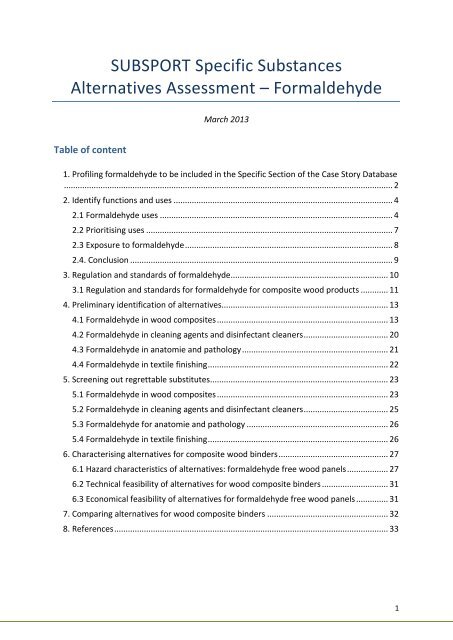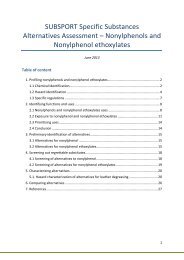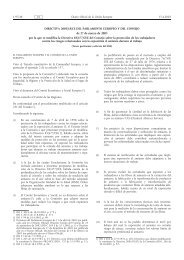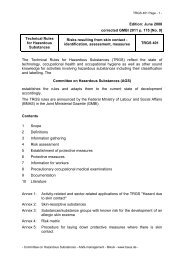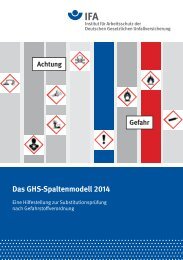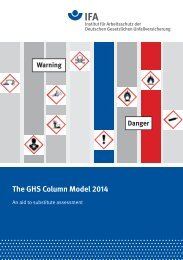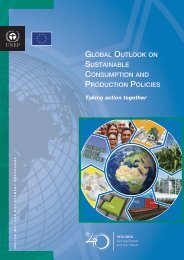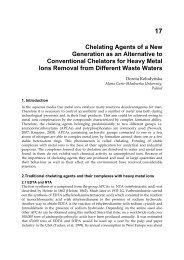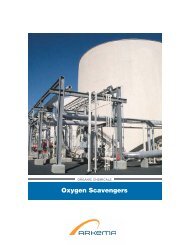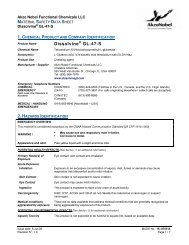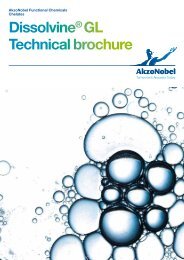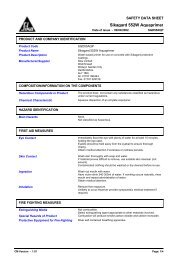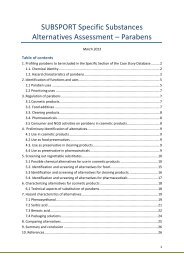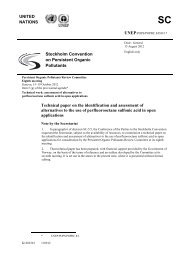Formaldehyde - Subsport
Formaldehyde - Subsport
Formaldehyde - Subsport
Create successful ePaper yourself
Turn your PDF publications into a flip-book with our unique Google optimized e-Paper software.
SUBSPORT Specific Substances<br />
Alternatives Assessment – <strong>Formaldehyde</strong><br />
March 2013<br />
Table of content<br />
1. Profiling formaldehyde to be included in the Specific Section of the Case Story Database<br />
................................................................................................................................................ 2<br />
2. Identify functions and uses ................................................................................................ 4<br />
2.1 <strong>Formaldehyde</strong> uses ...................................................................................................... 4<br />
2.2 Prioritising uses ............................................................................................................ 7<br />
2.3 Exposure to formaldehyde ........................................................................................... 8<br />
2.4. Conclusion ................................................................................................................... 9<br />
3. Regulation and standards of formaldehyde ..................................................................... 10<br />
3.1 Regulation and standards for formaldehyde for composite wood products ............ 11<br />
4. Preliminary identification of alternatives......................................................................... 13<br />
4.1 <strong>Formaldehyde</strong> in wood composites ........................................................................... 13<br />
4.2 <strong>Formaldehyde</strong> in cleaning agents and disinfectant cleaners ..................................... 20<br />
4.3 <strong>Formaldehyde</strong> in anatomie and pathology ................................................................ 21<br />
4.4 <strong>Formaldehyde</strong> in textile finishing ............................................................................... 22<br />
5. Screening out regrettable substitutes .............................................................................. 23<br />
5.1 <strong>Formaldehyde</strong> in wood composites ........................................................................... 23<br />
5.2 <strong>Formaldehyde</strong> in cleaning agents and disinfectant cleaners ..................................... 25<br />
5.3 <strong>Formaldehyde</strong> for anatomie and pathology .............................................................. 26<br />
5.4 <strong>Formaldehyde</strong> in textile finishing ............................................................................... 26<br />
6. Characterising alternatives for composite wood binders ................................................ 27<br />
6.1 Hazard characteristics of alternatives: formaldehyde free wood panels .................. 27<br />
6.2 Technical feasibility of alternatives for wood composite binders ............................. 31<br />
6.3 Economical feasibility of alternatives for formaldehyde free wood panels .............. 31<br />
7. Comparing alternatives for wood composite binders ..................................................... 32<br />
8. References ........................................................................................................................ 33<br />
1
1. Profiling formaldehyde to be included in the Specific Section of the Case<br />
Story Database<br />
Characterising formaldehyde based on its inherent hazards is an essential component of conducting<br />
an alternatives assessment (see SUBSPORT methodology, 2012). This approach allows the reviewer<br />
to assess whether or not an alternative is indeed preferable from an environmental, health and<br />
safety perspective. The hazard properties are intrinsic to the chemical, which means that regardless<br />
of the way that a chemical is used, these characteristics do not change (Table 1 and 2). The goal of<br />
the substitution processes is to advance inherently safer chemicals and products, consistent with the<br />
principles of green chemistry .<br />
Table 1: Classification of formaldehyde<br />
<strong>Formaldehyde</strong><br />
Chemical name (IUPAC) <strong>Formaldehyde</strong><br />
Identification number CAS 50-00-0<br />
EC 200-001-8<br />
Trivial names<br />
Formalin (aqueous), Formol, Formic aldehyde, Methaldehyde, Methanal, Methyl<br />
aldehyde, Superlysoform, Methylene oxide, Lysoform, FYDE, Dormol,<br />
Formalith, Tetraoxymethalene, Oxomethane, Oxymethylene, Morbicid,<br />
Paraformaldehyde, Paraform, Metaformaldehyd (solid polymer of formaldehyde)<br />
Substance function disinfectant, preservative, food additive fumigant, stabilizer, starch modifier, drying<br />
agent<br />
Classification Carc Cat. 3<br />
R23/24/25<br />
R34<br />
R40<br />
R43<br />
H351<br />
H331<br />
H311<br />
H301<br />
H314<br />
H317<br />
Source: ESIS - European chemical<br />
Substances Information System<br />
Sources that have been checked for hazard characterisation:<br />
1. SUBSPORT Hazardous Substance Database according to SUBSPORT Screening Criteria, SDSC,<br />
including:<br />
a. CLP Regulation (CMR 1A or 1B)<br />
b. IARC (group 1, 2A or 2B carcinogens)<br />
c. CLP Regulation (Sensitiser: H317, H334)<br />
d. EC PBT Working Group<br />
e. OSPAR List of Substances of Possible Concern (PBT)<br />
f. EC Endocrine Disruptors Database<br />
g. SIN List (endocrine disruptors)<br />
h. Vela et al. (neurotoxins, cat 2-4)<br />
2. The ESIS database for R and H phrases<br />
3. TOXNET/HSDB (hazardous substances database)<br />
2
For green house gases and ozone depleting substances:<br />
4. Greenhouse gases- Kyoto protocol- Annex A, as presented in IPCC (intergovernmental panel on<br />
climate change)<br />
5. Ozone Depleting Substances List (Montreal Protocol)<br />
6. Additional sources have been checked for information, especially for endpoints where no<br />
information is available in the previous mentioned sources, and also for getting the most up-to-date<br />
information. These sources include:<br />
• REACH registration dossiers<br />
• Search for scientific studies using the search resources Google scholar PubMed.<br />
• The endocrine disruption exchange list of potential endocrine disrupting substances:<br />
• Ordinary google search<br />
Table 2: Hazard characteristics of formaldehyde<br />
Properties<br />
Source of information<br />
Physical Hazards<br />
Explosivity Not applicable GHS Classification<br />
Flammability<br />
conclusive but not sufficient for<br />
classification<br />
Cat. 1<br />
ECHA registred substances,<br />
data dossier formaldehyde<br />
(2012)<br />
GHS Classification<br />
Oxidizing<br />
Other properties of reactivity -<br />
conclusive but not sufficient for<br />
classification<br />
ECHA registred substances,<br />
data dossier formaldehyde<br />
Human Health Hazards<br />
Acute toxicity<br />
Highly toxic<br />
Toxic if swallowed H301<br />
Toxic in contact with skin H311<br />
Toxic if inhaled H331<br />
SDSC – (SUBSPORT 2013),<br />
CLP, List of harmonised<br />
classification and labelling of<br />
hazardous substances<br />
Skin or eye corrosion / irritation Skin Corr. 1B SDSC (2012)<br />
Chronic toxicity<br />
Carcinogenicity Carc. 2<br />
CLP, List of harmonised<br />
classification and labelling of<br />
hazardous substances<br />
Carc. Cat 3<br />
ESIS, Annex I to Directive<br />
67/548/EEC<br />
group 1, 2A or 2B carcinogens IARC (2006)<br />
Mutagenicity<br />
Germ cell mutagenicity conclusive ECHA registered substances,<br />
but not sufficient for classification data dossier formaldehyde<br />
(2013)<br />
Reproductive toxicity (including conclusive but not sufficient for ECHA registered substances,<br />
developmental toxicity)<br />
classification<br />
data dossier formaldehyde<br />
(2013)<br />
Endocrine disruption -<br />
Respiratory or skin sensitization Skin Sens. 1 SDSC (SUBSPORT, 2013)<br />
Neurotoxicity -<br />
Immune system toxicity -<br />
3
Properties<br />
Systemic Toxicity<br />
Toxic metabolites<br />
Environmental Hazards<br />
Acute/chronic aquatic toxicity Cat 2<br />
Toxic to aquatic organism<br />
Bioaccumulation<br />
Persistence<br />
Greenhouse gas formation<br />
potential<br />
Experiments performed on a variety<br />
of fish and shrimp show no<br />
bioconcentration of formaldehyde<br />
Not classified<br />
Not classified<br />
<strong>Formaldehyde</strong> in the air breaks<br />
down in sunlight during the day into<br />
carbon monoxide and formic acid, a<br />
component of acid rain.<br />
Source of information<br />
GHS classification<br />
PAN Pesticide Database<br />
(2013)<br />
OECD, ChemPortal (2012)<br />
TURI (2006)<br />
TURI (2006)<br />
2. Identify functions and uses<br />
2.1 <strong>Formaldehyde</strong> uses<br />
A key first step in identifying appropriate alternatives is to determine the functions, uses and<br />
processes associated with formaldehyde, as potential feasible and safer alternatives are often differ<br />
particularly where a substance has numerous disparate applications. Table 3 provides an overview<br />
about formaldehyde uses.<br />
<strong>Formaldehyde</strong> is a high volatile gaz and is soluble in water, ethanol and diethyl ether. It is mostly sold<br />
as aqeuos solution containing 37 to 50% formaldehyde and 10 to 15% methanol (afsset, 2004). It is<br />
also present in solid form as paraformaldehyde, a polymer of formaldehyde.<br />
<strong>Formaldehyde</strong> is widely used in the industry. Annually 21 Million tones of formaldehyde are used all<br />
over the world in 2006, and 3 Million tones in Europe in 2007 (IARC, 2006). It has four basic uses: as<br />
an intermediate in the production of formaldehyde based resins; as an intermediate in the<br />
production of industrial chemicals and plastics; as a bactericide or fungicide; and as a component in<br />
the formulation of end-use consumer items such as cosmetics, shampoos and glues. <strong>Formaldehyde</strong><br />
is also used as embalming fluid and in textile treating to impart wrinkle-resistance to clothing (United<br />
States Department of Labour, 1992).<br />
Construction/remodeling activity, vehicle/motor and furniture production, and original equipment<br />
manufacture (OEM) account for most world consumption of formaldehyde (IHS, 2012).<br />
<strong>Formaldehyde</strong> is also used in health care sector for desinfection and as preserving agent for various<br />
vaccines and in laboratories and in funeral services to conserve biomaterials.<br />
Resins<br />
Urea-, phenol- and melamine-formaldehyde resins (UF, PF and MF resins) accounted for about 63%<br />
of world demand in 2011 (IHS, 2012).<br />
The over-all main use is for the production of urea-formaldehyde resins (UF). UF is widely used in the<br />
industry as binding material for particle boards and medium density pfibreboard (MDF) and plywood,<br />
and as components of melamine-phenolic resins for production of laminated flooring board.<br />
4
According to GlopbalInsight UF accounted for 55% (about 5.4 million metric tons) of EU25<br />
+Norwegian formaldehyde consumption in 2004 (GlobalInsight, 2007).<br />
Melamine formaldehyde (MF) has an excellent water and weather resistance, as well as chemical and<br />
heat resistance. It is used for the impregnation of paper for surfacing of wood-based panel products<br />
(e.g. laminate), as wood adhesives where improved water resistance is required (Pizzi, 2006), and<br />
also as molding compound. The automobile industry also uses MF resins such as clear coats and<br />
molding compound. MF consumption in the EU25 + Norway in 2004 was about 1.3 million metric<br />
tons.<br />
The next largest formaldehyde consumption in EU25 + Norway in 2004 is for phenolic formaldehyde<br />
(PF) resins. PF is water resistant and has fire resistant properties. It is used in the automobile industry<br />
( e.g. brake linings, friction material, foundry resins), in the electroindustry (e.g. printed circuit<br />
boards and insulators), as well as in the construction industry as water resistant wood adhesive, and<br />
as binders in mineral wool insulation. Consumption in the EU25 + Norway in 2004 about 75,000<br />
metric tons.<br />
Intermediate in the production of industrial chemiclas<br />
<strong>Formaldehyde</strong> is used as intermediate in the production of<br />
• EDTA (Ethylenediaminetetraacetic acid)<br />
• 1.4-butanediol (BDO)<br />
• Pentaerythritol<br />
• Isocyanates (MDI)<br />
Biocide: Bactericide and Fungicide<br />
HMTA (Hexamethylenetetramine) is used as biocide/preservative. Consumption in the EU25 +<br />
Norway in 2004 about 25,000 metric tons. Hexamethylenetetramine (Hexamine) is a crystalline, solid<br />
material, which is produced starting from <strong>Formaldehyde</strong> and Ammonia and which is mainly used in<br />
the resin and rubber industry.)<br />
<strong>Formaldehyde</strong> as aequous solution (formalin) in health care, laboratory, funeral service as<br />
disinfectant, preservative, embalming solution.<br />
Tabel: 3 <strong>Formaldehyde</strong> uses - overview<br />
Sector Function Product, article Source of<br />
information<br />
Binding agents/resins/<br />
adhesivs for different<br />
materials<br />
16. Manufacture of wood<br />
and of products of wood<br />
and cork, except<br />
furniture….<br />
16.21 Manufacture of<br />
veneer sheets and woodbased<br />
panels<br />
16. Manufacture of wood<br />
and of products of wood<br />
and cork, except<br />
furniture….<br />
Binding agent<br />
• Binder for wood,<br />
plywood,<br />
chipboard<br />
• Binder for<br />
structural wood<br />
panels<br />
surfacing of panels: laminats<br />
and surface coating<br />
Wood articles<br />
Wood articles<br />
http://www.form<br />
aldehydefacts.org<br />
/applications/com<br />
mon_uses/<br />
http://www.icis.c<br />
om/v2/chemicals/<br />
9076013/formald<br />
ehyde/uses.html<br />
http://www.form<br />
5
31. Manufacture of<br />
furniture<br />
23. Manufacture of other<br />
non-metallic mineral<br />
products<br />
23.14 Manufacture of<br />
glass fibers<br />
17. Manufacture of paper<br />
and paper products<br />
Binding agent<br />
• Glue<br />
Binding agent<br />
• Binder for glass<br />
wool, mineral wool<br />
Impregnation agent<br />
• paper<br />
impregnating<br />
resins for surfacing<br />
Polymer preparations<br />
and compounds<br />
Polymer preparations<br />
and compounds<br />
Stone, plaster,<br />
cement, glass and<br />
ceramic articles<br />
Paper and board dye,<br />
finishing,<br />
impregnation and<br />
care products<br />
aldehydeeurope.org/filead<br />
min/formaldehyd<br />
e/PDF/Socio-<br />
Economic-<br />
Benefits-<br />
Study.pdf<br />
http://www.icis.c<br />
om/v2/chemicals/<br />
9076013/formald<br />
ehyde/uses.html<br />
http://www.icis.c<br />
om/v2/chemicals/<br />
9076013/formald<br />
ehyde/uses.html<br />
Disinfectants/Preservativ<br />
es<br />
86. Health care Biocide<br />
• Disinfectant<br />
96.03 Funeral and related<br />
activities<br />
Fixing agent<br />
Biocide<br />
• Embalming<br />
solution<br />
81.2 Cleaning activities Biocide<br />
Cleaning agents: wax<br />
blends, biocidal products,<br />
Washing and cleaning<br />
products<br />
Biocoide<br />
Cosmetics, personal care<br />
products<br />
75. Veterinary activities Biocide<br />
• Disinfectant<br />
Manufacture of plastic<br />
articles<br />
29.3 Manufacture of<br />
parts and accessories for<br />
motor vehicles<br />
Manufacture of<br />
chemicals<br />
20.3 Manufacture of<br />
paints, varnishes and<br />
similar coatings, printing<br />
ink and mastics<br />
Binding agent<br />
Processing aid<br />
• Component of<br />
thermoplastic<br />
engineering<br />
polymer<br />
Biocide<br />
• Bactericide,<br />
fungicide,<br />
preservative,<br />
Paper articles<br />
Biocidal product<br />
Biocidal product<br />
wax blends, biocidal<br />
products, Washing<br />
and cleaning<br />
products<br />
Biocidal product<br />
Polymer preparations<br />
and compounds<br />
Plastic articles<br />
Biocidal product<br />
Polymer preparations<br />
and compounds<br />
http://www.icis.c<br />
om/v2/chemicals/<br />
9076013/formald<br />
ehyde/uses.html<br />
http://plastics.du<br />
pont.com/plastics<br />
/pdflit/europe/del<br />
rin/DELDGe.pdf<br />
http://www.osha.<br />
gov/pls/oshaweb/<br />
owadisp.show_do<br />
cument?p_table=<br />
6
germicide<br />
PREAMBLES&p_id<br />
=923<br />
20. Manufacture of<br />
chemicals and chemical<br />
products<br />
20.4 Manufacture of soap<br />
and detergents, cleaning<br />
and polishing<br />
preparations, perfumes<br />
and toilet preparations<br />
Biocide<br />
• Preservative,<br />
bactericide,<br />
germicide<br />
Biocidal product<br />
Pharmaceuticals<br />
http://www.osha.<br />
gov/pls/oshaweb/<br />
owadisp.show_do<br />
cument?p_table=<br />
PREAMBLES&p_id<br />
=923<br />
Textile finishing<br />
13.3 Finishing of textiles Impregnation agent<br />
• Resin to impart<br />
wrinkle-resistance<br />
to clothing. Also<br />
used as fire<br />
retardation,<br />
increased water<br />
repellency, and<br />
stiffness<br />
Textile dyes, finishing<br />
and impregnating<br />
products<br />
http://www.osha.<br />
gov/pls/oshaweb/<br />
owadisp.show_do<br />
cument?p_table=<br />
PREAMBLES&p_id<br />
=923<br />
http://www.nclab<br />
or.com/osha/etta<br />
/indguide/ig31.pd<br />
f<br />
Beside the uses mentioned in table 3 formaldehyde is also used in the leather industry as tanning<br />
agent, in agriculture for seed treatment, soil disinfection, and as a insecticide and fungicide, as a<br />
biocide in drilling fluids; as a stabilizer in gasoline and as film hardener. As these uses covers only a<br />
minor part of the formaldehyde consumtion, they are not subject of this case study.<br />
2.2 Prioritising uses<br />
As described in the previous chapter formaldehyde has four basic uses: as an intermediate in the<br />
production of formaldehyde based resins; as an intermediate in the production of industrial<br />
chemicals and plastics; as a bactericide or fungicide; and as a component in the formulation of enduse<br />
consumer items such as cosmetics, shampoos and glues. According to Globalinsight and<br />
Formacare the consumption of formaldehyde is the highest in the production of formaldehyde resins<br />
(tab. 4)<br />
Table 4: Main downstream derivates and their consumtion of formaldehyde in EU25 + Norway in<br />
2004<br />
Main downstream derivate products<br />
of formaldehyde<br />
EU25 + Norway consumption of<br />
formaldehyde in 2004<br />
Urea-formaldehyde resins UF 55%<br />
Melamine-formaldehyde resins MF 14%<br />
Phenol-formaldehyde resins PF 7%<br />
Polyacetal resins POM 6%<br />
1.4 Butanediol BDO 4%<br />
Pentaerythritol 3%<br />
(Source GlobalInsight, 2007)<br />
7
2.3 Exposure to formaldehyde<br />
Humans may be exposed to formaldehyde in the environment and in the workplace. <strong>Formaldehyde</strong><br />
concentrations in the environment generally are reported in parts per billion, but exposure levels are<br />
much higher in the workplace, occurring in the range of parts per million (National Toxicology<br />
Program, 2011)<br />
Afsset published a report in 2009 dealing with the exposure of workers to formaldehyde (Afsset,<br />
2009). According to this report about 105 different occupations were exposed to formaldehyde.<br />
Most occupations belongs to the healthcare sector, manufacture of furniture, manufacture of resins,<br />
and agriculture. Examples of occupations exposed to formaldehyde are listed in table 5. According to<br />
the report, which analysed the SUMER data, about 193,000 workers were exposed to formaldehyde<br />
in France in 2003. Most of them were working in the health care sector (including laboratory workers<br />
and workers in anatomy and pathology), followed by the manufacture of furniture, resins and plastic<br />
compounds (Afsset, 2009).<br />
Lissner et al. (Expokoll, unpublished, 2012) analysed the EXPO Database which indicates that 80% of<br />
all workers in Norway were exposed to formaldehyde between 2007 and 2009.<br />
Industrial workers who produce formaldehyde or formaldehyde-containing products, embalmers and<br />
workers in pathology may be exposed to higher levels of formaldehyde than other workers (National<br />
Cancer Institute, 2011).<br />
Table 5: Occupations exposed to formaldehyde<br />
Occupations exposed to formaldehyde<br />
Agriculture workers<br />
Laboratory researchers/workers<br />
Botanists<br />
Lacquer producers and users<br />
Carpet manufacturers/installers Medical professionals<br />
Disinfectant producers/users<br />
Oil field workers<br />
Dressmakers<br />
Paint and varnish manufacturers<br />
Drug makers<br />
Paper manufacturers<br />
Dye manufacturers<br />
Plastics manufacturers<br />
Embalming fluid producers<br />
Plywood and particle board<br />
Fabric store personnel<br />
manufacturers<br />
Fertilizer manufacturers and blenders Poultry processors<br />
<strong>Formaldehyde</strong> producers<br />
Rubber workers<br />
<strong>Formaldehyde</strong> resin producers<br />
Sanitation workers<br />
Foundry workers<br />
Science instructors/teachers<br />
Furniture makers and finishers<br />
Taxidermists<br />
Glue and adhesive makers<br />
Textile workers: finishers, printers,<br />
Hazardous waste handlers<br />
cutters<br />
Ink makers<br />
Veterinarians<br />
Insulators<br />
Wood preservers<br />
(source: N.C. Department of Labor, 2009)<br />
The Michigan Department of Licensing and Regulatory Affairs grouped workers according to their<br />
formaldehyde exposure level: the highest exposure is among workers producing hardwood plywood,<br />
particle board, fiberboard and resins as well as workers in foundries, laboratories and funeral<br />
services (exposure levels between 0.1 to above 1.0 ppm), followed by industries in textile finishing,<br />
8
apparel manufacturing, formaldehyde production and plastic molding (0.1 to 1.0 ppm) and workers<br />
in pulp, paper and paperboard mills , softwood plywood manufacturers, manufacturers of various<br />
cardboard and paper products, paint, pigment and dye manufacturers, photo finishing labs,<br />
hemodialysis units, biology.<br />
Although the use of formalin as biocide (< 1%) is very low compared to the overall production of<br />
formaldehyde in Europe (FriedliPartner AG, 2007), workers are at high exposure to formaldehyde in<br />
health care, laboratory, pathology and funeral services.<br />
Workers in health care facilities cleaning surfaces with cleaners containing formaldehyde may be<br />
exposed to formaldehyde levels far beyond stipulated occupational exposure limits (OELs), although<br />
formaldehyde is used in high dilution (0.5 to 3%) (Eickmann and Thullner, 2006).<br />
<strong>Formaldehyde</strong> levels during embalming can be very high, up to 4 ppm, with average levels greater<br />
than 0.5 ppm (NINCAS 2007).<br />
Textile plant workers working in plants using formaldehyde containing finishes may also be exposed<br />
to higher levels of formaldehyde. Adults, children and babys wearing textiles treated with<br />
formaldehyde are at risk of potential health effect from dermal exposure to formaldehyde e.g.<br />
contact dermatitis or other forms of eczema.<br />
2.4. Conclusion<br />
The exposure to formaldehyde is a big issue in sectors with a high formaldehyde consumption as well<br />
as in sector were many workers are exposed to formaldehyde or are exposed to a high amount of<br />
formaldehyde. Based on the above information, formaldehyde is most used for the production of<br />
resins (about 76%). The sector with the most workers exposed to formaldehyde is the health care<br />
sector and the occupation with the highest exposure of formaldehyde are anatomists, pathologist<br />
and tanatologists.<br />
<strong>Formaldehyde</strong> in textile finishing is an issue especially for children and baby wear.<br />
For this reason substitution examples in this report will focus on substitution of formaldehyde<br />
• in wood composites,<br />
• in disinfectant cleaners in health care and<br />
• in funeral services, anatomy and pathology, and<br />
• in textile finishing<br />
9
3. Regulation and standards of formaldehyde<br />
The International Agency for Research on Cancer (IARC) 1 changed its classification of formaldehyde<br />
from a group 2A substance "probably carcinogenic to humans" to group 1 "carcinogenic to humans"<br />
in 2004. The main source of formaldehyde emission general population is from breathing indoor and<br />
outdoor air. Indoor formaldehyde emmission is caused by different sources, including off-gassing<br />
from numerous construction and home-furnishing products. Concerns relating to formaldehyde<br />
exposure has therefore advanced the research for alternative resins and wood binders that do not<br />
contain formaldehyde (National Toxicology Program, 2011) (Forest and Wood products Australia,<br />
2010).<br />
The European Union has developed a strategic policy for protection of workers against risks from<br />
dangerous substances. It aims to prevent or limit the exposure of workers to dangerous substances<br />
at workplaces, and to protect the workers that are likely to be exposed to these substances. Setting<br />
occupational exposure limits (OELs) is an essential part of this political strategy.<br />
The European Commission defines two different OELs: indicative OELs and binding OELs which are<br />
published in the directives listed in table 6.<br />
Table 6: EU Directives setting occupational exposure limits (OELs)<br />
Indicative OELs<br />
Binding OELs<br />
− First list of indicative occupational<br />
exposure limit values (Directive<br />
− Chemical Agents Directive<br />
(Directive 98/24/EC)<br />
2000/39/EC)<br />
− Cancer Directive (Directive<br />
− Second list of indicative<br />
2004/37/EC)<br />
occupational exposure limit values<br />
(Directive 2006/15/EC)<br />
− Asbestos Directive (Directive<br />
2009/148/EC)<br />
− Third list of indicative occupational<br />
exposure limit values (Directive<br />
2009/161/EU)<br />
STEL (ppm)<br />
For <strong>Formaldehyde</strong> they have not yet defined any OEL. But the European Union Scientific Committee<br />
on Occupational Exposure Limit Values (SCOEL) proposed in 2008 an eight hour exposure limit of 0.2<br />
ppm and short term exposure limit (STEL) of 0.4 ppm. They regard formaldehyde as a genotoxic<br />
carcinogen. SCOEL is mandated to advise the European Commission on occupational exposure limits<br />
for chemicals in the workplace. Other recommendations are listed in table 7.<br />
1 IARC: http://www.iarc.fr/<br />
10
Table 7: OEL recommendations for formaldehyde (Bolt, 2012)<br />
TWA -8h (ppm) - 8 hour<br />
time-weighted average<br />
STEL (ppm) - short-term<br />
exposure limit<br />
ACGIH 2 (USA, 2006) -<br />
0.3<br />
DECOS 3 (NL) + Nordic (2003) 0.12<br />
0.42<br />
DFG 4 /MAK (D, 2006) 0.3<br />
0.6<br />
SCOEL 5 (EU, 2006) 0.2<br />
0.4<br />
OELs in the EU Member States are set by competent national authorities or other relevant national<br />
institutions as limits for concentrations of hazardous compounds in workplace air (EU OSHA, 2012).<br />
These OELs are published as a legal text by an authority. The OELs differ between EU Member<br />
States. The reasons for this include divergence in assessment methods and differing assessments on<br />
the actual risks of the chemicals themselves. It is often not possible to compare exposure limits<br />
between countries because of the differing approaches (EU OSHA, 2012).<br />
Table 8 shows the current exposure limits for formaldehyde in some EU Member States. As limits<br />
frequently change, it is necessary to consult the relevant national authorities for latest information.<br />
Table 8: Current occupational exposure limits for formmaldehyde in some EU Member States<br />
TWA -8h (ppm) - 8 hour timeweighted<br />
average<br />
STEL (ppm) - short-term<br />
exposure limit<br />
Denmark 0.3<br />
Finland 0.3 1<br />
France<br />
0.5 (VME = Valeur limite de<br />
moyenne d’exposition 8-h)<br />
1 (VLE= Valeur limite d’exposition<br />
– 15 min)<br />
Germany 0.3 (MAK/TWA 8- h) 0.6<br />
Ireland*<br />
2 (maximum exposure limit (MEL) for 2<br />
both TWA -8h and STEL)<br />
Poland 0.5 1<br />
Spain 0.3<br />
Sweden 0.5 1<br />
The Netherlands 1 1.5<br />
UK**<br />
2 (maximum exposure limit (MEL) for<br />
both 8 hour TWA -8h STEL)<br />
2<br />
*will be revised in 2013 to 0.3 ppm (TWA -8h); ** currently under review and subject to possible change<br />
3.1 Regulation and standards for formaldehyde for composite wood products<br />
Acceptable levels of formaldehyde emission from composite wood products have been continously<br />
reduced over the last years. In 1980 some European countries started to regulate formaldehyde<br />
emissions and developped an obligatory emission class E1 (0.1 ppm boards) for wood-based panels<br />
1985. 2004, Europe established the emission classes E1 and E2 (European Standard EN 13986)<br />
regarding wood products used in construction, in 2006 emission class E1 became obligatory for panel<br />
production. Also North America and Japan established emission standards and occupational<br />
2 ACGIH = American Conference of Governmental Industrial Hygienists: http://www.acgih.org/<br />
3 DECOS = Dutch Expert Committee on Occupational Standards<br />
4 DFG = Deutsche Forschungsgemeinschaft: http://www.dfg.de/<br />
5 SCOEL = European Union Scientific Committee on Occupational Exposure Limit Values:<br />
http://ec.europa.eu/social/main.jsp?catId=148&langId=en&intPageId=684<br />
11
exposure levels for formaldehyde (Regulation and standards: ASTM (North America), CEN (Europe),<br />
GB (China), JIS/JAS (Japan), JANZ (Australia) and ISO (international). This lead to a change in<br />
formulation of fomaldehyde resins. (Athanassiadou, 2009).<br />
The German guideline (ETB-Richtlinie, 1980 6 ) classifies particleboard according to their<br />
formaldehyde release into three different emmission classes: E1, E2, E3 (table 9)<br />
Table 9: <strong>Formaldehyde</strong> emission class for particleboard in Germany<br />
Emission class Equilibrium concentration in a Perforator value (mg/100g dry board)<br />
40 m³ test chamber<br />
E1 ≤ 0.1 ppm 6.5 mg/100 g dry board<br />
E2 0.1 – 1.0 ppm 10 – 30 mg/100 g dry board<br />
E3 1.0 – 2.3 ppm 30 – 60 mg/100 g dry board<br />
European formaldehyde limits for wood based panels are summarised in the harmonised standard<br />
EN 13986. This standard includes two emmission classes E1 and E2 (E1 ≤ 8mg/100g dry board; E2 >8<br />
- ≤ 30 mg/100g dry board. Germany, Austria, Denmark and Sweden require compliance with emission<br />
limits of 6.5mg/100g dry board.<br />
The Blue Angel certification for environmental friendly products require a formaldehyde emission<br />
limit of 0.05 ppm. The European panel federation (EPF 7 ) decided to draw up its own standard, the<br />
EPF-S: for PB 4mg/100g and for MDF (with > 8 mm thickness) 5 mg/100g. In 2011, EPF agreed on a<br />
reduction in formaldehyde emissions for CE labeled, uncoated wood panels for construction (EN<br />
13986). The new limit value should be determined using the chamber test method described in EN<br />
717-1 and should not exceed 0.065ppm. IKEA also set an own emission limit that is half E1 (0.05<br />
ppm)(IOS-MAT-003) 8 .<br />
Japanese guideline<br />
Japan Agricultural Standards (JAS) were first established in 1953 and has been revisyed several times<br />
since. In 2003,the standards for plywoods were unified. Japanese JIS/JAS 9 emission standards are<br />
broken down into four levels labeled as F*, F**, F***, and F****. The emission standards are<br />
measured in mg/L and are therefore difficult to compare with European standards, which are<br />
measured in ppm (parts per million) (table 10). All composite wood products should be marked with<br />
a formaldehyde emission grade that determines the use of the product: e.g. F**** plywood can be<br />
used interior without limitations . F**, F***, plywood can be used interior with some limitations. F*<br />
plywood is not allowed to be used interior .<br />
All products must be approved by the Japanese Ministry through an extensive application process<br />
that includes providing of desiccator data (JIS 1460) at minimum (Franklin Adhesive and Polymers,<br />
2013).<br />
6 ETB-Richtlinie über die Verwendung von Spanplatten hinsichtlich der Vermeidung unzumutbarer<br />
Formaldehydkonzentrationen in der Raumluft (1980),<br />
http://www.beuth.de/de/verwaltungsvorschrift/spanplatterlrderl-nw/3531270<br />
7 http://www.europanels.org/<br />
8 The natural step, IKEA, a natural step case study, http://www.naturalstep.org/it/usa/ikea<br />
9 Japan Agricultural Standard JAS; Japan Industrial Standard JIS<br />
12
Table 10: <strong>Formaldehyde</strong> emission class for particleboard in Japan<br />
Emission class<br />
Limit value<br />
(Desiccator test JIS A<br />
1460)<br />
Perforator value (EN<br />
120)<br />
F** ≤ 1.5 mg/L 6.5 mg/100 g dry<br />
board<br />
F*** “E0” ≤ 0.5 mg/L 2.5 mg/100 g dry<br />
board<br />
F**** “SE0” (Super<br />
E0)<br />
≤ 0.3 mg/L<br />
1.5 mg/100 g dry<br />
board<br />
Closed to the emission of<br />
solid untreated wood<br />
North American guidelines<br />
The National voluntary standard ANSI A208.1 & 2 ; The standard has been revised in 2011 by the<br />
American National Standards Institute (ANSI). It includes new grades and product categories as well<br />
as harmonisation with the formaldehyde emission ceilings and other requirements recently enacted<br />
by the California Air Resources Board (CARB) (Surface and Panel, 2011).<br />
According to the Healthy building network (2012) “The California Air Resources Board established<br />
new regulations in April 2007 to regulate formaldehyde emissions from composite wood products,<br />
including particle board, MDF (medium density fiberboard), and interior plywood. The two step<br />
process set limits on emissions for products manufactured after January 1 (table 11), 2009 that will<br />
be roughly equivalent to the majority of the European and Japanese standards and will exceed them<br />
with stricter limits in 2010 (and 2012 for some products).” (Composite Panel Association, 2008)<br />
Table 11: Phases for formaldehyde emission in California<br />
HWPW*- HWPW- PB MDF MDF Thin<br />
VC 10 CC<br />
Phase 1 0.08 ppm 0.08 ppm 0.18 ppm 0.21 ppm 0.21 ppm Effective from 2009<br />
Phase 2 0.05 ppm 0.05 ppm 0.09 ppm 0.11 ppm 0.13 ppm Effective from 2010 or<br />
2011<br />
*HWPW Hartwood/plywood<br />
Conclusion<br />
All standards set limit for formaldehyde emissions only for wood panels that are already produced.<br />
The emission levels protects the end users, carpenters and workers in the furniture industry by<br />
reducing users exposure to formaldehyde. But the chemicals used may put the workers at risk during<br />
the production of the binders, or of the composite wood products.<br />
4. Preliminary identification of alternatives<br />
4.1 <strong>Formaldehyde</strong> in wood composites<br />
The main use of adhesives in the wood industry, includes plywood, oriented strandboard,<br />
particleboard, fiberboard, structural composite lumber, doors, windows and frames, and factorylaminated<br />
wood products. This section provides examples of alternatives for formaldehyde in wood<br />
panels and binders available on the market. The alternatives include<br />
• Drop-in materials or chemicals<br />
• Changes to component/product design<br />
10 HWPW = Hartwood/plywood<br />
13
Table 12 lists the alternatives with product examples. They are listed without priority, and are not<br />
assessed by SUBSPORT in this chapter. An evaluation and prescreening of the listed alternatives can<br />
be found in chapter 5.<br />
The alternatives summarised in table 12 are all no-added formaldehyde (NAF) based resins. NAF<br />
based resins are resins formulated with no added formaldehyde as part of the resin cross linking<br />
structure, and include resins made from soy, polyvinyl acetate, or methylene diphenyl diisocyanate<br />
(MDI)”, (Air Resource Board, 2013). The table does not include ultra-low-emitting formaldehyde<br />
(ULEF) resins, because they are made with formaldehyde and still emit low amounts of it.<br />
Substitution of formaldehyde in wood panel may be done by substituting the formaldehyde based<br />
adhesive by an alternative product or by substitution through alternative materials such as cement<br />
bonded particle boards.<br />
Many factors have to be considered when selecting the best adhesive for a particular application.<br />
Different applications require different technical properties of the adhesives such as: Strength,<br />
durability, wetting, consistency, pressure, temperature, moisture content, color and finishing, and<br />
costs (Frihart & Hunt, 2010).<br />
3.1.2.1 Alternative resins – short overview<br />
A. Synthetic resins<br />
One group of alternative wood adhesives/resins contain isocyanates. Isocyanate- based adhesives<br />
have risen the interest of the industry because they have advantages compared to formaldehyde<br />
based resins. They have a high internal bond strength, better elasticity and mode of rapture (MOR),<br />
they are more efficient and highly effective in lower doses, and cure at higher wood moisture<br />
contents and they do not emit formaldehyde (Tan, 2012).<br />
Methylenebis(4-phenyl isocyanate) (MDI ) binders are for example used in over 20 percent of the<br />
high growth OSB (oriented strand board) industry worldwide and are in routine production in MDF<br />
(medium density fiberboard) mills in Europe and North America (Papadopulus et al. 2001). But it<br />
should be noted that MDI is synthesized with formaldehyde.<br />
The examples below describe in brief three synthetic resins based on isocyanates:<br />
Methylenebis(4-phenyl isocyanate) MDI or pMDI<br />
a. Use: for wood-based products such as exterior particleboard, exterior OSB, laminated strand<br />
lumber (LSL), MDF, or other specially engineered composites/ Flakeboards;particleboard, strandwood<br />
products<br />
b. Properties: High dry and wet strength; very resistant to water and damp atmosphere; adheres to<br />
metals and plastics, good wetting and penetration behavior,<br />
c. Compounds/composition: pMDI is produced during the manufacturing of monomeric MDI. pMDI<br />
is produced by phosgenation of di-, tri-, and higher amines and contains a mixture of the three<br />
different isomers (Dunky, 2003)<br />
Polyurethane adhesives<br />
a. Use: General purpose home and shop; construction adhesive for panelised floor and wall<br />
systems; laminating plywood to metal and plastic sheet materials; specialty laminates<br />
14
. Properties: High dry and wet strength; resistant to water and damp atmosphere; limited<br />
resistance to prolonged and repeated wetting and drying; gap-filling<br />
c. Compounds/composition: Polyurethane adhesives are formed by the reaction of various types of<br />
isocyanates with polyols.<br />
Emulsion polymer isocyanate (EPI)<br />
a. Use: Laminated beams for interior and exterior use; lamination of plywood to steel metals and<br />
plastics; doors and architectural materials<br />
b. Properties: High dry and wet strength; moisture resistance, resistant to prolonged and repeated<br />
wetting and drying; adheres to metals and plastics<br />
c. Compounds/composition: two part system based on an acrylate, polyurethane or vinyl acetate<br />
and a isocyanate hardener (GlobalInsight, 2005)<br />
The following two alternative synthetic resins are water-borne adhesives widely used in the assembly<br />
of wood and paper products (Frihart, 2005). They are made by emulsion polymerisation, which uses a<br />
free radical addition mechanism to polymerise the monomere in presence of water and stabiliser<br />
(Geddes, 2003).<br />
Polyvinyl acetate (PVA)/ Ethyl vinyl acetate (EVA)<br />
a. Use: general purpose in home and shop, assembly of wood and paper products, used for wood<br />
bonding, such as furniture construction<br />
b. Properties: High dry strength; low resistance to moisture and elevated temperatures; joints yield<br />
under continued stress<br />
c. Compounds/composition: linear polymers with an aliphatic backbone. Polyvinyl acetate is made<br />
by the self-polymerization of vinyl acetate usually under free radical conditions.<br />
Acrylic adhesives<br />
a. Use: surface treating, paper traeting, insulation binder<br />
b. Properties: bonds well to plastics, and to metals, but not to wood, expensive,<br />
Epoxy<br />
a. Use: Laminating veneer and lumber in cold-molded wood boat hulls; assembly of wood<br />
components in aircraft; lamination of architectural railings and posts; repair of laminated wood<br />
beams and architectural building components;laminating sports equipment; general purpose<br />
home and shop, not used often for wood because of their high cost.<br />
b. Properties: High dry and wet strength to wood, metal, glass, and plastic; formulations for wood<br />
resist water and damp atmospheres; delaminate with repeated wetting and drying<br />
c. Compounds/composition: created by polymerizing acrylic or methylacrylic acids through a<br />
reaction with a suitable catalyst. Acrylic adhesives and acrylate adhesives cure through a free<br />
radical mechanism<br />
B. Natural resins<br />
Natural resins can be divided in five different classes (Afsset, 2009):<br />
Resins made from:<br />
1. Tannins<br />
2. Lignins<br />
3. Carbohydrates<br />
4. Proteins<br />
5. Unsatturated fatty acids<br />
Bioresins made from proteins<br />
15
a. Use: Decorative plywood for interior use, laminated flooring, particleboard, and oriented<br />
strandboard (OSB)<br />
b. Properties: acording to the producer and user of a soybased resin (Purebon, 2013), it has the<br />
same properties like formaldehyde based resins.<br />
c. Compounds/composition: mainly soy-protein-based<br />
Bioresins made from Tannins<br />
a. Use: Decorative plywood for interior use, laminated flooring, particleboard, and oriented<br />
strandboard, (OSB), particle board, medium density fibreboard, Partial replacement for<br />
phenolic adhesives in composites and plywood panel products.<br />
b. Properties: high viscosity, inconsistent reactivity, composition varies according to growing<br />
conditions.<br />
c. Compounds/composition: polyhydroxypolyphenolic isolated from plants<br />
C. Examples of alternative materials for interior use<br />
Cement bonded particle boards<br />
a. Use: Cement-bonded particleboard is used for making bookcases, cabinet-ends and<br />
countertops, making it a useful interior-remodeling choice. The surface of particleboard is<br />
often laminated to make it look like hardwood. Flooring with tongue and grooved boards,<br />
large size prefabricated elements for permanent shuttering of concrete walls and floors,<br />
production of complete prefabricated houses.<br />
b. Properties: fire resistant, mould and insect resistant, frost resistant, sound insulation,<br />
resistant against weather conditions<br />
c. Compounds/composition: cement boards are a combination of cement and reinforcing<br />
fibers. Cement boards are mainly cement bonded particle boards and cement fibre. Cement<br />
bonded particle boards have treated wood flakes as reinforcement, whereas cement fibre<br />
boards have cellulose fibre, which is a plant extract as reinforcement. Portland cement acts<br />
as binder in both the cases.<br />
Gypsum boards<br />
a. Use: . It is used to make interior walls and ceilings.<br />
b. Properties: Gypsum board walls and ceilings have several advantages such as: Ease of<br />
installation, Fire resistance, Sound isolation, Durability, Economy, Versatility<br />
c. Compounds/composition: Gypsum board are panels made of gypsum plaster pressed<br />
between two sheets of paper There exist other ”gypsum panel products” that contain a<br />
gypsum cor, but can be faced with a variety of different materials, including paper and<br />
fiberglass mats (Gypsum association, 2012). To produce gypsum board, the calcined gypsum<br />
is mixed with water and additives to form a slurry which is sandwiched between two pieces<br />
of paper . The paper becomes chemically and mechanically bonded to the core.<br />
Clay building boards<br />
a. Use: It is suitable for all interior areas, especially for low energy buildings.<br />
b. Properties: Once coated with a clay skim finish the surface can take picture hooks, wallpaper<br />
and paints, clay surfaces absorb and diffuse water vapour, clay absorbs odours, clay surfaces<br />
are cool in summer, warm in winter, Clay is exceptionally good at reducing noise levels’<br />
Greenspec, 2012) .<br />
c. Compounds/composition: Clay boards are 100% natural. Clay is one of the earliest used<br />
basic building materials.Clay building boards are made wood materials or other natural plantfibres<br />
like reed coated with clay.<br />
16
Table 12: Examples of alternatives for formaldehyde in wood panels:<br />
Alternative Product examples Description (from companies’ website) Producer, Contact, information<br />
Chemical alternatives<br />
Synthetic resins<br />
Methylenebis<br />
(4-phenyl<br />
isocyanate)<br />
MDI or PMDI<br />
PVA<br />
PU Binder<br />
DHF/DFF panels from<br />
EGGER (Germany)<br />
Three-layer panels<br />
bonded with PVAC<br />
Medium density<br />
fibreboard (MDF), no<br />
added formaldehyde<br />
(NAF)<br />
e.g. TOPAN MDF Standard<br />
FF from Glunz (Germany)<br />
Orientated strand board<br />
(OSB) panels<br />
e.g.<br />
EUROSTRAND OSB 4 TOP<br />
from EGGER (Germany)<br />
DHF and DFF boards are board-shaped wood-based materials made out of<br />
wood fibre according to EN 622-5 (DHF) and EN 13171 (DFF). They have a<br />
tongue and groove profile along the edges. The boards are manufactured<br />
using the so-called dry method in a hot press process and with addition of a<br />
PMD glue and paraffin wax emulsion for hydrophobising.<br />
“Environmentally-friendly PVA glue is used on HAAS solid wood panels, and<br />
that is good news for persons who suffer from allergies. There are no<br />
hazardous emissions from HAAS solid wood panels. The natural ability of<br />
wood to absorb and release moisture contributes to a healthy room climate.<br />
HAAS solid wood panels enhance the feeling of well-being” Text from HAAS<br />
website<br />
Binder for TOPAN MDF FF is a formaldehyde-free polyurethane (PUR)<br />
adhesives.<br />
uses PU binder = formaldehyde-free gluing (E1< 0,03 ppm). Classified as<br />
OSB/4 board according EN 300. The board complies with the strict<br />
requirements of the Federal Association of German Prefabricated<br />
Construction (BDF/QDF) in terms of emissions and the requirements of the<br />
Japanese F****,standard with regard to the level of desiccation (a<br />
measurement of formaldehyde).<br />
EGGER<br />
http://www.egger.com/downloads/bildarchiv/430<br />
00/1_43592_ZF_EPD_OSB-Platten_DE_2011.pdf)<br />
HAAS, http://www.haasgroup.com/hp2329/Solid-wood-panels.htm<br />
Glunz<br />
http://www.glunz.de/produkt_dekorativ/gruppe/<br />
221<br />
EGGER<br />
http://www.egger.com/downloads/bildarchiv/430<br />
00/1_43592_ZF_EPD_OSB-Platten_DE_2011.pdf)<br />
17
Alternative Product examples Description (from companies’ website) Producer, Contact, information<br />
Bioresins<br />
Bioresins<br />
(e.g. from<br />
Soybean,<br />
Linseed,<br />
Rapeseed)<br />
Tannins<br />
PureBond<br />
Glyoxalized lignin/<br />
mimosa tannin/hexamine<br />
Soybased resins: PureBond: Soy based plywood adhesive see TURI “Five<br />
chemicals study”<br />
“Columbia's Purebond veneer core panel is made with hardwood species<br />
wood glued together with soy flour "blended with a very small amount of<br />
proprietary resin," according to Columbia's website. That resin is Hercules<br />
Inc. chemical Kymene®, 624 Wet Strength Resin, now called<br />
ChemVisionsTM CA1000, a liquid cationic amine polymer-epichlorohydrin<br />
amine called polyamide-epichlorohydrin (PAE).”<br />
The green adhesive can be considered to be produced industrial. All<br />
properties of the adhesives correspond to the needs for an industrial panel<br />
production.<br />
http://www.lepetitsitesante.fr/Documents/Dossiers/110620_formaldehyd<br />
e_panneaux_verts.pdf<br />
http://www.turi.org/library/turi_publications/five<br />
_chemicals_study/final_report/chapter_4_formal<br />
dehyde<br />
Project “Panneaux Verts”<br />
Contact:<br />
Sandra Tapin-Lingua sandra.tapin-lingua@fcba.fr<br />
Michel Petit-Conil@webCTP.com<br />
Material change and design change substitutes<br />
Alternative<br />
Material<br />
Cement-bonded<br />
particleboard (Portland<br />
cement) (CBPB)<br />
e.g. CETRIS<br />
Versapanel<br />
Or Aquapanel cement<br />
board<br />
Cement-bonded particle board CETRIS: free from green asbestos,<br />
formaldehyde, isocyanates, wood preservatives and fungicides, made from<br />
chip wood particles with cement.<br />
Additives can be: Aluminum sulfate, calcium hydroxide, sodium silicate<br />
http://www.lubw.badenwuerttemberg.de/servlet/is/31686/zementgebundene_spanplatten.pdf?co<br />
mmand=downloadContent&filename=zementgebundene_spanplatten.pdf<br />
Cement-bonded particleboards are frost-resistant and weather-proof,<br />
flame resistant or hardly inflammable.<br />
They are resistant against mold and fungus and provide no food value to<br />
insects. <strong>Formaldehyde</strong>-free<br />
CETRIS, http://www.cetris.cz/en/systems/wallingsystems/cetris-basic-board/<br />
Versapanel,<br />
http://www.euroform.co.uk/pdf/versapanel/VERS<br />
APANEL%20MANUAL%20Jan%202010%20Current<br />
.pdf<br />
Knauf Perlite<br />
http://www.perlite.de/innenwand_FAQ.html<br />
18
Alternative Product examples Description (from companies’ website) Producer, Contact, information<br />
Claybuilding<br />
boards<br />
Pavaclay<br />
„Pavaclay”, is a wood fibre and clay board designed for use in dry<br />
construction. PAVACLAY provides ideal room air quality because of its<br />
hygroscopic and capillary properties. The system stabilizes air humidity<br />
within a pleasant range. In addition, clay and wood fiber offer an ideal<br />
capacity to act as a heat reservoir, as a result of its high specific heat<br />
storage capacity. Of special interest to all those interested in healthy living<br />
is the fact that clay purifies the air, since, similar to activated charcoal, the<br />
enormous surface leads to a high absorption. Due to the great mass and<br />
the high insulating property, PAVACLAY additionally improves noise<br />
insulation in areas exposed to high noise levels. (from the website (pavatex)<br />
http://www.pavatex.de/tabid/467/language/en-GB/Default.aspx)<br />
Product data sheet:<br />
http://pavatex.de//Portals/0/content/Dokumente<br />
/Datenblaetter_Deutschland/9_Pavaclay_Produkt<br />
datenblatt_D.pdf<br />
Hardwood Plywood Veneer Core, Hardwood Plywood Composite Core, Particleboard, Medium Density Fiberboard, Thin Medium Density Fiberboard (max.<br />
thickness 8 mm), (TURI, 2006)<br />
Abbreviations used:<br />
CARB<br />
CBPB<br />
MDF<br />
MDI<br />
NAF<br />
NIH<br />
OS<br />
OSB<br />
PF<br />
PMDI<br />
PU<br />
PUR<br />
PVAC<br />
RAC<br />
UF<br />
California Air Resource Board<br />
cement bonded particle board<br />
medium density fibreboard<br />
methylene bisphenyl isocyanate<br />
no added formaldehyde<br />
The National Institutes of Health (NIH), a part of the U.S. Department of Health and Human Services<br />
oriented strandboard<br />
oriented strand board<br />
phenol-formaldehyde<br />
polymeric diphenyl methane diisocyanate or polymer methylene bisphenyl isocyanate<br />
polyurethane<br />
polyurethane<br />
polyvinylacetate<br />
committee for Risk Assessment<br />
urea-formaldehyde<br />
19
4.2 <strong>Formaldehyde</strong> in cleaning agents and disinfectant cleaners<br />
Environmental cleaning is a key in preventing infections in various facilities. A high hygienic standard<br />
is required in several facilities such as: health care facilities, live stock farming, schools, sanitary<br />
facilities, canteens, food manufacture. Cleaning has here a dual function: surface cleanliness, and<br />
infection prevention and control. This requires intensive and frequent cleaning with a wide range of<br />
products including disinfectants. (Markkanen et al., 2009).<br />
<strong>Formaldehyde</strong> is a broad spectrum disinfectant and is active against bacteria, fungi and many viruses<br />
and spores. It is used to disinfect surfaces in a 0.5 – 5% solution. Its mechanism of action is based on<br />
protein denaturation (Kayser et al., 2001).<br />
Routine disinfection of health care facilities is very common. <strong>Formaldehyde</strong> is often used in surface<br />
disinfectant cleaners. However, cleaning and disinfection are two different processes and not<br />
required for all rooms and surfaces. Cleaning is the mechanical or chemical removal of dirt from an<br />
object or an area. Normally, cleaning with soap or other detergents followed by rinsing with water is<br />
sufficient to remove visible dirt and also germs.Thorough cleaning without disinfectants can remove<br />
50 to 80% of germs (Robert Koch Institut, 2004). But it should be noticed and taken into account that<br />
cleaning water without disinfectant show a high contamination with germs, that is not found in<br />
disinfectant cleaners. So that cross-contamination may occure . Disinfection is defined as the<br />
destruction of microorganisms and can be achieved by physical (e.g. heat) or chemical methods.<br />
However, surfaces must be clean before chemical disinfectants will work. Disinfectants are products<br />
that contain biocidal active substances with antimicrobial properties. These destroy the spread of<br />
harmful organisms. Their use is particularly required in high risk areas of specific industrial and<br />
institutional areas.<br />
Cleaning in health care and other facilities such as retirement homes or hotels is often linked with<br />
disinfectant cleaners containing biocides (e.g. formaldehyde, glutaraldehyde, ethanol, isopropanol).<br />
The function of disinfectants is to kill microorganism (cytotoxicity), but they may also be hazardous<br />
for the environment and human health. Alternatives for harmful surface cleaning are described in<br />
different reports from Health Care without harm (2013).<br />
The WIDES Database (2013) was developped by Vienna Ombuds Office for Environmental Protection<br />
(Austria) in cooperation with the network ÖkoKauf Wien to support the selection of effective and<br />
safe product for disinfection and cleaning in health care. It is an industry independent user-friendly<br />
information system.<br />
The alternatives in table 13 are listet without priority, and are not assessed by SUBSPORT. A<br />
prescreening of the alternatives can be found in chapter 5.2.<br />
20
Table 13: Alternatives for formaldehyde in disinfectant cleaners<br />
<strong>Formaldehyde</strong> use<br />
Surface cleaning and disinfectant agents<br />
Alternatives<br />
Chemical alternatives:<br />
- Glutaraldehyde<br />
- Hydrogen peroxid<br />
- Ortho-phthalaldehyde<br />
- Peracetic acid<br />
- Chlorine dioxide<br />
- Quaternary ammonium compounds (benzalkonium<br />
chloride)<br />
Non chemical alternative:<br />
- microfiber mopping<br />
- Cleaning machines that require minimal chemicals.<br />
- Substitution through organisational measures:<br />
Cleaning areas depending on the level of<br />
disinfection required from an infection prevention<br />
and control perspective.<br />
- Substitution through design: Selection of flooring<br />
material that reduces the need of cleaning with<br />
disinfectants (sorce: green cleaning program of<br />
Magee-Women’s hospital)<br />
4.3 <strong>Formaldehyde</strong> in anatomie and pathology<br />
<strong>Formaldehyde</strong> is extensively used for preserving cadavers in anatomy or funeral services.<br />
Embalming includes the processes intended to delay the decomposition of a cadaver and prepare it<br />
for funeral. To prevent the decomposition of the body, the embalmer injects aqueous solutions of<br />
formaldehyde the concentration of which depends on how much the body has changed.<br />
For anatomical studies it is extremely important to fix and preserve cadavers adequately for<br />
anatomical studies. However, preservation of human bodies for anatomical preparations poses a<br />
health risk for workers and students in gross anatomy laboratories (Al-Hayani et al. 2011). Medical<br />
students has shown to be exposed to formaldehyde concentrations greater than 5 ppm during<br />
macroscopic examinations (Hammer et al. 2011). This has resulted in closure of German dissecting<br />
rooms in medical schools in order to protect students. Safer alternatives are necessary to keep up<br />
high-quality gross anatomy training and also to ensure the quality of medical staff education. Some<br />
alternatives are listed in table 14.<br />
Anatomists, pathologists, and funeral industry workers exposed to formaldehyde for a prolonged<br />
time, were more at risk to face lymphohematopoietic cancer and brain (Graf, 2009).<br />
Case stories about successful substitution in scientific laboratories can be found in the SUBSPORT<br />
case story database (2013)and in the CatSub database.<br />
21
Table 14: Alternatives for formaldehyde in anatomy and pathology<br />
<strong>Formaldehyde</strong> use<br />
Alternatives<br />
Anatomie - Ethanol-glycerin fixation with thymol<br />
conservation 11<br />
- Shellack resin in ethanol 12<br />
- Fixall-his (Ethanol, acetic acid, propan-2-ol) see<br />
case story No 012 in the SUBSPORT database.<br />
- 1-Methyl-3-octyloxymethylimidazolium<br />
tetrafluoroborate see case story No 40 in the<br />
SUBSPORT database<br />
- Ethanedial see case story No 41 in the SUBSPORT<br />
database<br />
- Ethanol see case story No 93 in the SUBSPORT<br />
database. You will find more case stories using<br />
ethanol in the catsub database.<br />
Tissue fixative – non chemical alternative - Freazing<br />
- Freaze drying<br />
- Cryosubstitution<br />
Pathology - PROPAN-2-OL (Freedom Cave) 13<br />
Pathology - non chemical solution - Refrigeration<br />
4.4 <strong>Formaldehyde</strong> in textile finishing<br />
The textile finishing procedure includes preparation and pretreatment, dyeing, printing and<br />
refinement of fabrics and are used to make the fabric wrinkle resistant, to prevent shrinkage, or<br />
increase its resistance to slow combustion. <strong>Formaldehyde</strong> is used in the textile industry among<br />
others to impart wrinkle-resistance to clothing. Concerns about formaldehyde emmissions from<br />
clothes and other fabrics has stimulated the development of safer alternatives releasing less or no<br />
formaldehyde. Some alternatives are listed in table 16.<br />
Fabrics are treated with urea-formaldehyde resins to give them all sorts of easy care properties such<br />
as:<br />
• Permanent press / durable press<br />
• Anti-cling, anti-static, anti-wrinkle, and anti-shrink (especially shrink proof wool)<br />
• Waterproofing and stain resistance (especially for suede and chamois)<br />
• Perspiration proof<br />
• Moth proof<br />
• Mildew resistant<br />
• Color-fast<br />
Ecolable and Oeko-Tex set standards for formaldehyde release in textile (table 15)<br />
Table 15: Limits for formaldhyde release by Ecolable and Oeko-Tex Standard taken from Piccinini et<br />
al. 2007<br />
11 http://jnci.oxfordjournals.org/content/early/2011/02/14/jnci.djr035.full<br />
12 http://www.medwelljournals.com/fulltext/?doi=javaa.2011.1561.1567<br />
13 http://www.dodge-uk.com/pdf/MSDS/German/Cavities/Freedom%20Cav%20-%20SDS10155%20-<br />
%20German.pdf<br />
22
Textiles for<br />
babies<br />
Textiles in<br />
direct contact<br />
with skin<br />
Textile without<br />
direct contact<br />
with skin<br />
Decoration<br />
material<br />
Ecolable 30 mg/kg 300 mg/kg 300 mg/kg<br />
Oeko-Tex < 20 mg/kg 75 mg/kg 300 mg/kg 300 mg/kg<br />
Table 16: Alternatives for formaldehyde in textile finishing – wrinkle resistance<br />
<strong>Formaldehyde</strong> use<br />
Alternatives<br />
Finishing of textiles – wrinkle resistance - Chitosan<br />
- Dimethyl urea glyoxal<br />
- Polyvinylpyrrolidone<br />
- Polymaleic acid<br />
5. Screening out regrettable substitutes<br />
The purpose of this chapter is to eliminate any alternatives that would pose a high risk to the<br />
environment or human health. SUBSPORT developed a database containing substances that are not<br />
acceptable as alternative due to their hazards. The alternatives are all screened against this database<br />
(table 17-20). It can be found on the SUBSPORT database of Hazardous Substances (SDSC) by<br />
following this link: http://www.subsport.eu/case-stories-database. If a substance meets any of the<br />
SUBSPORT screening criteria, it is removed from further consideration as an appropriate alternative,<br />
unless the author (SUBSPORT) regards the alternative safer than the original substance.<br />
5.1 <strong>Formaldehyde</strong> in wood composites<br />
Tabel 17: Alternatives screened against SUBSPORT database of Hazardous Substances (SDSC)<br />
Chemical alternative comments SDSC source<br />
MDI/PMDI<br />
Diphenylmethane<br />
diisocyanate/<br />
polymeric MDI<br />
Cas No.:<br />
4,4’ MDI: 101-68-8<br />
4,2’ MDI: 2536-05-2<br />
2,2’ MDI: 5873-54-2<br />
Mix of Isomeres<br />
26447-40-5<br />
Contains Isocyanates: polymeric<br />
MDI (PMDI), the primary<br />
technical/commercial form of MDI,<br />
is actually a mixture that contains<br />
25–80% monomeric 4,4'-MDI as<br />
well as oligomers containing 3–6<br />
rings and other minor isomers,<br />
such as the 2,2'-isomer. The exact<br />
composition of PMDI varies with<br />
the manufacturer.<br />
MDI is<br />
included in<br />
the SDSC<br />
because of<br />
sensitising<br />
properties.<br />
H317, H334<br />
Toxicological review by EPA:<br />
http://www.epa.gov/iris/toxreviews/0<br />
529tr.pdf<br />
Isocyanates have a strong irritant<br />
effect on the respiratory tract. Some<br />
people may become sensitised to<br />
isocyanates, even at very low levels.<br />
PVA (polyvinyl<br />
acrylates)<br />
Cas No. : 9003-20-7<br />
Vinylacetate<br />
Cas No. : 108-05-04<br />
Water based latex glue, polymere<br />
of vinylacetate<br />
Acute (short-term) inhalation<br />
exposure of workers to vinyl<br />
acetate has resulted in eye<br />
irritation and upper respiratory<br />
tract irritation.<br />
Not included<br />
in SDSC<br />
Toxicological review by EPA<br />
http://www.epa.gov/ttnatw01/hlthef/<br />
vinylace.html<br />
23
Chemical alternative comments SDSC source<br />
PU<br />
9009-54-5<br />
Groupe : 61789-63-7<br />
Protein based<br />
bioresin: soybean oil<br />
Cas No.: 8001-22-7<br />
Tannins<br />
Cas No.: 1401-55-4<br />
Material alternative<br />
Cement bonded<br />
particle boards<br />
Portland cement Cas<br />
No. 65997- 15-1<br />
Polyurethanes contain isocyanate:<br />
they are formed between the<br />
reaction of a di-isocyanate and a<br />
polyol to form a urethane linkage<br />
Although Portland Cement is not<br />
listed in IARC as carcinogen, it may<br />
contain small amounts of naturally<br />
occurring, but potentially harmful,<br />
substances such as free crystalline<br />
silica or havy metals. Crystalline<br />
silica has been listed by IARC as a<br />
known human carcinogen (Group I)<br />
through inhalation.<br />
Exposure to wet portland cement<br />
can cause serious, potentially<br />
irreversible tissue (skin or eye)<br />
destruction in the form of chemical<br />
(caustic) burns or an allegoric<br />
reaction.<br />
PU is<br />
included in<br />
the SDSC<br />
because it<br />
contains<br />
isocyanate<br />
with<br />
sensitising<br />
properties.<br />
H317, H334<br />
Not included<br />
in SDSC<br />
Not l<br />
included in<br />
SDSC<br />
Not included<br />
in SDSC<br />
Toxicological review by EPA:<br />
http://www.epa.gov/iris/toxreviews/0<br />
529tr.pdf<br />
Isocyanates have a strong irritant<br />
effect on the respiratory tract. Some<br />
people may become sensitised to<br />
isocyanates, even at very low levels.<br />
Purebond, TURI, Purebond contains in<br />
small amounts epichlorohydrin, a<br />
carcinogen.<br />
(MSDS by Holcim, 2005)<br />
TURI (2006)<br />
hazard assessment HSE 14<br />
Clay boards<br />
No Cas No. for clay<br />
(Kaolin Cas No. 1332-<br />
58-7)<br />
Natural product<br />
Clay may contain Kaolin. Kaolin is a<br />
mixture of different minerals. Its<br />
main component is kaolinite and it<br />
frequently contains quartz, mica,<br />
feldspat, illite and montmorlilonite<br />
Not included<br />
in SDSC<br />
TOXNET<br />
14 http://www.hse.gov.uk/pubns/web/portlandcement.pdf<br />
24
5.2 <strong>Formaldehyde</strong> in cleaning agents and disinfectant cleaners<br />
Tabel 18: Alternatives screened against SUBSPORT database of Hazardous Substances (SDSC)<br />
Chemical alternative comments SDSC source<br />
Glutaraldehyde<br />
Cas No. 11-30-8<br />
Hydrogen peroxide<br />
Cas No. 7722-84-1<br />
Ortho-phthalaldehyde<br />
Cas No. 643-79-8<br />
Peracetic acid<br />
Cas No. 79-21-0<br />
Chlorine dioxide<br />
Quaternary ammonium<br />
compounds<br />
(benzalkonium chloride)<br />
C8-18: Cas No. 63449-<br />
41-2<br />
C12-18: Cas No. 68391-<br />
01-5<br />
Glutaraldehyde is a skin sensitiser<br />
and very toxic to aquatic life.<br />
Glutaraldehyde does not pass<br />
SUBSPORT criteria and will be<br />
therefore not be added as<br />
alternative in the case story<br />
database.<br />
Hydrogen peroxide imay cause<br />
severe skin burns and eye<br />
damages.<br />
Ortho-phthalaldehyde has no<br />
harmonised classification<br />
according to Annex VI of<br />
Regulation (EC) No 1272/2008<br />
(CLP Regulation). Please check<br />
also the ECHA’s Classification and<br />
Labelling Inventory.<br />
Peracetic acid is very toxic to<br />
aquatic life.<br />
Chlorine dioxide is very toxic to<br />
aquatic life.<br />
Quarternary ammonium<br />
compounds Cas No. 63449-41-2<br />
are very toxic to aquatic life<br />
Included in<br />
SDSC<br />
because of<br />
sensitizing<br />
properties.<br />
Not included<br />
in SDSC<br />
Not included<br />
in SDSC<br />
Not included<br />
in SDSC<br />
Not included<br />
in SDSC<br />
Not included<br />
in SDSC<br />
Non-chemical<br />
alternative<br />
microfiber mopping Non chemical alternative Not included<br />
Cleaning machines that<br />
require minimal<br />
chemicals<br />
Cleaning areas<br />
depending on the level<br />
of disinfection required<br />
from an infection<br />
prevention and control<br />
perspective<br />
Selection of flooring<br />
material that reduces<br />
the need of cleaning<br />
with disinfectants<br />
Non chemical alternative<br />
Substitution through<br />
organisational measures<br />
Substitution through design<br />
in SDSC<br />
Not included<br />
in SDSC<br />
Not included<br />
in SDSC<br />
Not included<br />
in SDSC<br />
SDSC,<br />
ESIS<br />
ESIS, SDSC<br />
ESIS,<br />
SDSC<br />
ESIS, SDSC<br />
ESIS, SDSC<br />
source: green cleaning program of<br />
Magee-Women’s hospital,<br />
25
5.3 <strong>Formaldehyde</strong> for anatomie and pathology<br />
Tabel 19: Alternatives screened against SUBSPORT database of Hazardous Substances (SDSC)<br />
Chemical alternative comments SDSC source<br />
Ethanol-glycerin<br />
fixation with thymol<br />
conservation<br />
Not included<br />
in SDSC<br />
The alternative is a mixture and is<br />
therefore categorised as other type<br />
of alternative.<br />
Glycerin is not included in the<br />
SDSC.<br />
Ethanol is included in the SDSC as<br />
being carcinogen 2A/2B (IARC)<br />
Thymol is not included in SDSC, but<br />
is toxic to aquatic life according to<br />
ESIS.<br />
SDSC, IARC, ESIS,<br />
Hammer et al. 2011<br />
Shellac resin in<br />
ethanol<br />
Shellac Cas No.<br />
9000-59-3<br />
Ethanol Cas No. 64-17-<br />
5<br />
PROPAN-2-OL<br />
(Freedom Cave)<br />
Cas No. 67-63-0<br />
Shellac is a natural polymer of<br />
animal origin. It is composed of a<br />
complex mixture aliphatic and<br />
alicyclic hydroxy acids.<br />
Ethanol is included in SDSC as<br />
carcinogen 2A/2B (IARC)<br />
Propan-2-ol is highly flammable<br />
Shellac is<br />
not included<br />
in SDSC<br />
Propan-2-ol<br />
is not<br />
included in<br />
SDSC<br />
ESIS, SDSC, IARC,<br />
Al-Hayani et al. 2011<br />
ESIS, SDSC, MSDS for Freedom Cave 15<br />
5.4 <strong>Formaldehyde</strong> in textile finishing<br />
Tabel 20: Alternatives screened against SUBSPORT database of Hazardous Substances (SDSC)<br />
Chemical alternative comments SDSC source<br />
Chitosan<br />
Cas No. 9012-76-4<br />
Chitosan is a natural<br />
polysaccharide extracted from<br />
crustacean shells<br />
Not included<br />
in SDSC<br />
SDSC, Anonymus, 2009<br />
Dimethyl urea glyoxal<br />
DMeDHEU<br />
N,N-dimethyl urea<br />
Cas No. 96-31-1<br />
Glyoxal Cas No. 107-<br />
22-2<br />
DMeDHEU is synthesised from N,Ndimethyl<br />
urea and glyoxal<br />
N,N-dimethyl urea<br />
Is not included in SDSC.<br />
Glyoxal is included in the SDSC<br />
being skin sentisiser (H317, H334).<br />
DMeDHEU is<br />
not included<br />
in SDSC<br />
SDSC, ESIS, Schwarcz, 2012<br />
Polyvinylpyrrolidone<br />
Cas No. 9003-39-8<br />
Polymaleic acid<br />
Cas No. 26099-09-2<br />
Maleic acid is included in SDSC<br />
because of skin sentisising<br />
properties (H317)<br />
Not included<br />
in SDSC<br />
Polymer not<br />
included in<br />
SDSC<br />
SDSC, ESIS, Hashem, 2009<br />
SDSC, ESIS, Periyasamy, 2012<br />
15 http://www.dodge-uk.com/pdf/MSDS/German/Cavities/Freedom%20Cav%20-%20SDS10155%20-<br />
%20German.pdf<br />
26
6. Characterising alternatives for composite wood binders<br />
Most of the identified synthetical alternative resins (MDI and PU ) did not pass the SUBSPORT<br />
criteria. SUBSPORT does not only look at the end product, but also at hazards that might put workers<br />
at risk e.g. in the production line. Wood panels produced with MDI or PU resins do not emit<br />
formaldehyde and do not contribute to formaldehyde emissions in the indoor air. But as they use<br />
isocyanate - a sensitiser - to bond wood composites, they will not be included in the SUBSPORT<br />
database of case stories. Portland cement raises different problems: it might contain free silica,<br />
which is a known cancerogen and wet Portland cement can damage/burn the skin.<br />
PVA adhesives are used to assemble wood parts in the furniture industry. Some companies use PVA<br />
to assamble three-layer solid wood panels (e.g. Haas, Germany). Commercially available PVA-based<br />
panels could not be identified by the author. PVA is not water resistant and not heat resistant. PVA<br />
can substitute urea formaldehyde resin or MDI only in a very small application range.<br />
The bioresins are still in the stage of development. Different research groups are developing<br />
bioresins (“green products”) for the wood and construction industry (panneaux verts, Neolignin 16 ).<br />
The alternative material such as clay boards can also be used only in a very small application range.<br />
Clay boards can mainly be used indoors as structural panels. Clay may also contain small amounts<br />
free crystalline silica and heavy metals.<br />
6.1 Hazard characteristics of alternatives: formaldehyde free wood panels<br />
A detailed documentation and hazard assessment on formaldehyde in wood panels and possible<br />
alternatives has been done by the Toxics Use Reduction Institute in Massachusetts (TURI, 2006). The<br />
hazard assessment of SUBSPORT follows the SUBSPORT methodology (table 21-23). Afsset the French<br />
Agency for Environmental and Occupational Health Safety (since 2010 the French Agency for Food,<br />
Environmental and Occupational Health and Safety ANSES) published a detailed French study about<br />
formaldehyde in its divers uses and possible alternatives (Afsset, 2009)<br />
Table 21: Hazard characteristics of soy bean resin used for Purebond (based on soil bean oil CAS<br />
8001-22-7 and known additives)<br />
Properties<br />
Source of information<br />
Soy bean oil CAS 8001-22-7: This substance is not classified in the Annex I of Directive 67/548/EEC<br />
Physical Hazards<br />
Explosivity<br />
Not applicable<br />
GHS<br />
Not explosive European Comission 17<br />
Not applicable<br />
GHS<br />
Flammability<br />
May be combustible at high<br />
European Comission<br />
temperature<br />
Oxidizing<br />
Not applicable<br />
GHS<br />
Not oxidising<br />
European Comission<br />
Other properties of reactivity Not applicable<br />
16 http://www.lepetitsitesante.fr/Documents/Dossiers/110620_formaldehyde_panneaux_verts.pdf<br />
17 Review of Annex IV of the regulation No 1907/2006 (REACH), evaluation of existing entries, Appendix 2,<br />
retrieved at: http://ec.europa.eu/environment/chemicals/reach/pdf/6B%20Appendix%202.pdf<br />
27
Human Health Hazards<br />
Acute toxicity<br />
Highly toxic<br />
Skin or eye corrosion / irritation<br />
Properties<br />
Not applicable<br />
Not applicable<br />
Slightly toxic in case of skin and eye<br />
contact<br />
Source of information<br />
European Commisiion<br />
Not listed in IARC, CLP and ESIS, CLP, List of harmonized<br />
Carcinogenicity<br />
classification and labbeleing<br />
of hazardous substances<br />
ESIS<br />
Mutagenicity<br />
Not listed<br />
Reproductive toxicity (including Not listed<br />
developmental toxicity)<br />
Endocrine disruption<br />
Not listed<br />
OECD, EU Endocrine disruptor<br />
database, SIN list<br />
Respiratory or skin sensitization<br />
Not listed<br />
CLP<br />
Not sensitising<br />
European Comission<br />
Neurotoxicity Not listed Vela et al. 2003<br />
Immune system toxicity<br />
Systemic Toxicity<br />
Toxic metabolites<br />
Acute/chronic aquatic toxicity Not applicable<br />
No aquatic toxicity<br />
European Comisson<br />
Bioaccumulation<br />
Not applicable<br />
biodegredable<br />
European Commission<br />
Persistence<br />
Not applicable<br />
Greenhouse gas formation<br />
Not listed<br />
Kyoto Protocol, Annex A<br />
potential<br />
Ozone-depletion potential Not listed Montreal Protocol<br />
Monitoring – has the substance<br />
been found in human or<br />
environmental samples?<br />
Epichlorohydrin CAS 106-89-8<br />
Physical Hazards<br />
Explosivity<br />
Due to the molecular structure the<br />
prediction of explosive properties is<br />
ECHA registered substances,<br />
data dossier epichlorohydrin<br />
negative<br />
Flammability Flamm Liq. 3 CLP, SDSC<br />
Oxidizing<br />
Other properties of reactivity<br />
Human Health Hazards<br />
Acute toxicity<br />
Highly toxic Acute tox 3: H331, H311, H301 CLP, SDSC<br />
Skin or eye corrosion / irritation Skin Corr 1B CLP, SDSC<br />
Carcinogenicity<br />
Mutagenicity<br />
Cat 2A,<br />
Carc 1B<br />
No data<br />
IARC, SDSC<br />
CLP, SDSC<br />
28
Properties<br />
Source of information<br />
No adverse reproductive effects in scorecard<br />
Reproductive toxicity (including<br />
humans were reported in available<br />
developmental toxicity)<br />
studies<br />
Endocrine disruption Cat 1 EU EDC DB, SDSC<br />
Respiratory or skin sensitization Skin sens 1 CLP, SDSC<br />
Neurotoxicity Not listed SDSC, Vela et al, 2003<br />
Immune system toxicity<br />
Systemic Toxicity<br />
Toxic metabolites<br />
Acute/chronic aquatic toxicity<br />
Bioaccumulation<br />
No data<br />
Toxicity to aquatic organisms<br />
Toxicity to aquatic organisms<br />
Data waving<br />
bioconcentration in aquatic<br />
organisms is low<br />
CLP<br />
PAN<br />
SIGMA Aldrich safety data<br />
sheet<br />
ECHA registered substances,<br />
data dossier epichlorohydrin<br />
TOXNET/HSDB<br />
Persistence no Environment Canada<br />
Greenhouse gas formation<br />
Not listed<br />
Kyoto Protocol, Annex A<br />
potential<br />
Ozone-depletion potential Not listed Montreal Protocol<br />
Monitoring – has the substance<br />
been found in human or<br />
environmental samples?<br />
Table 22: Hazard characteristics of clay boards<br />
Properties<br />
Source of information<br />
Physical Hazards: This substance is not classified in the Annex I of Directive 67/548/EEC<br />
Explosivity<br />
Not applicable<br />
Flammability<br />
Not applicable<br />
Oxidizing<br />
Other properties of reactivity<br />
Human Health Hazards<br />
Acute toxicity<br />
Highly toxic<br />
Skin or eye corrosion / irritation<br />
Not applicable<br />
no<br />
Not applicable<br />
Not applicable<br />
Carcinogenicity Not listed in IARC, CLP and ESIS, CLP, List of harmonized<br />
classification and labbeleing<br />
of hazardous substances<br />
ESIS, IARC<br />
Mutagenicity Not listed CLP, SDSC<br />
Reproductive toxicity (including Not listed<br />
CLP, SDSC<br />
developmental toxicity)<br />
Endocrine disruption Not listed OECD, EU Endocrine disruptor<br />
database, SIN list (ChemSec<br />
2013)<br />
Respiratory or skin sensitization Not listed CLP<br />
29
Properties<br />
Source of information<br />
Neurotoxicity Not listed Vela et al., 2003<br />
Immune system toxicity<br />
Not applicable<br />
Systemic Toxicity<br />
Not applicable<br />
Toxic metabolites<br />
Not applicable<br />
Acute/chronic aquatic toxicity Not applicable<br />
Bioaccumulation<br />
Not applicable<br />
Persistence<br />
Natural product<br />
Greenhouse gas formation<br />
Not listed<br />
Kyoto Protocol, Annex A<br />
potential<br />
Ozone-depletion potential Not listed IPCC, Montreal protocol<br />
Monitoring – has the substance<br />
been found in human or<br />
environmental samples?<br />
*Clay may contain small amounts free crystalline silica and heavy metals. Workers producing or<br />
working with clayboards (e.g. when sawing clayboards) may be at risk of dust.<br />
Table 23: Hazard characteristics of PVA (CAS 9003-20-7)<br />
Properties<br />
Source of information<br />
Physical Hazards<br />
Explosivity No MSDS,<br />
http://www.carlroth.de/jsp/dede/sdpdf/9154.PDF<br />
Flammability No MSDS,<br />
http://www.carlroth.de/jsp/dede/sdpdf/9154.PDF<br />
Oxidizing No MSDS,<br />
http://www.carlroth.de/jsp/dede/sdpdf/9154.PDF<br />
Other properties of reactivity<br />
Human Health Hazards<br />
Acute toxicity<br />
Highly toxic<br />
Skin or eye corrosion / irritation<br />
No toxic or other hazards are<br />
associated with the use of this latex<br />
adhesive<br />
May cause irritation in respiratory<br />
tract and eyes<br />
Toxnet/HSDB<br />
U.S. EPA<br />
Carcinogenicity Not listed in IARC, CLP and ESIS, CLP, List of harmonized<br />
classification and labbeleing of<br />
hazardous substances<br />
ESIS, SDSC<br />
Mutagenicity Not listed SDSC<br />
Reproductive toxicity (including Not listed<br />
SDSC<br />
developmental toxicity)<br />
Endocrine disruption Not listed OECD, EU Endocrine disruptor<br />
database, SIN list (ChemSec<br />
2013)<br />
Respiratory or skin sensitization Not listed CLP<br />
Neurotoxicity Not listed Vela et al. 2003<br />
Immune system toxicity<br />
30
Systemic Toxicity<br />
Toxic metabolites<br />
Properties<br />
Source of information<br />
Acute/chronic aquatic toxicity Not applicable<br />
Bioaccumulation<br />
Not applicable<br />
Persistence<br />
Not biodegradeble<br />
Greenhouse gas formation Not listed<br />
Kyoto Protocol, Annex A<br />
potential<br />
Ozone-depletion potential Not listed Montreal Protocol<br />
Monitoring – has the substance<br />
been found in human or<br />
environmental samples?<br />
6.2 Technical feasibility of alternatives for wood composite binders<br />
The alternatives based on bioresins are mainly in the stage of research. A research group in France<br />
working on tannins as alternative, are close to develop an alternative ready for industrial use (see<br />
SUBSPORT case story No. 201).<br />
Currently, the use spectrum of the presented alternatives is not as broad as for formaldehyde-based<br />
or isocyanate-based resins. It is necessary to improve the performance of alternative resins (e.g.<br />
bioresins) to push the substitution of formaldehyde based wood panels. Bioresins able to compete<br />
with formaldehyde- or isocyanate-based resins need additives that may be hazardous. PureBond ® is<br />
one of the biobased resin that is already produced for industrial uses. It is used by Columbia Forest<br />
Products for hardwood plywood manufacturing. It reaches similar performances as formaldehyde<br />
based resins.<br />
Alternative material like cement or clay are produced in an industrial scale. Cement bonded particle<br />
boards can be used outside and indoors, but they have a high weight. Clay boards can only be used<br />
in doors.<br />
Poly vinyl acetate, PVA is a water-borne adhesives that is widely used for wood bonding, such as<br />
furniture construction. PVAs do not work well at high moisture levels (Frihart, 2010). PVA can be<br />
used to bond three layer panels such as solid wood panels from hardwood (e.g. from Tilly or Haas).<br />
These wood panels are not weather resistant and not suitable for outside uses.<br />
6.3 Economical feasibility of alternatives for formaldehyde free wood panels<br />
Taking into account, that the presented alternatives are suitable for different uses<br />
(indoors/outside/construction/ interior works/furniture construction) it is difficult to compare the<br />
costs.<br />
Purebond is currently available at a similar cost to formaldehyde-based plywood (TURI, 2006,<br />
Purebond, 2013).<br />
Clayboards are currently more expensive than traditional formaldehyde-based structural panels<br />
(Naturbauhof, 2013).<br />
The author has no information for the PVA bonded three layer panels.<br />
31
7. Comparing alternatives for wood composite binders<br />
Health aspects<br />
Environmental<br />
aspect<br />
Bioresins/PureBond Clay boards PVA<br />
PROS: no hazardous<br />
PROS:<br />
substances (tannins,<br />
lignins)<br />
CONS: PureBond contains<br />
Epichlorohydrin (Classified<br />
by IARC group 2A).<br />
According to US EPA<br />
(1984) it is completely<br />
consumed in the batch<br />
manufacturing process<br />
used to make the resin.<br />
Other bioresins intended<br />
for industrial production<br />
contains also small<br />
amounts of dangerous<br />
substances (e.g. )<br />
PROS: readily<br />
biodegradable; natural<br />
product<br />
PROS: natural product,<br />
not suspected to<br />
contain dangerous<br />
substances<br />
PROS: not<br />
biodegradable, but<br />
natural component of<br />
the soil<br />
CONS: some PVA glues<br />
include an isocyanate<br />
catalyst (isocyanates<br />
are sensitisers and can<br />
cause asthma and<br />
dermatitis<br />
PROS:<br />
CONS:<br />
No information<br />
Performance<br />
aspects<br />
PROS: Purebond:<br />
performance aspects<br />
similar to formaldehydebased<br />
plywood<br />
PROS: very good<br />
properties regarding<br />
the indoor air and<br />
moisture<br />
PROS: excellent<br />
performance<br />
characteristics for<br />
interior (TURI, 2006)<br />
Cost aspects<br />
CONS: most of the<br />
bioresins are still in the<br />
stage of development<br />
PROS: PureBond: currently<br />
available at a similar cost to<br />
formaldehyde-based<br />
plywood (TURI, 2006,<br />
Purebond<br />
CONS: can substitute<br />
<strong>Formaldehyde</strong> only in<br />
a small range.<br />
CONS: currently more<br />
expensive than<br />
traditional<br />
formaldehyde-based<br />
structural panels<br />
(Naturbauhof, 2013)<br />
CONS : PVA is not<br />
waterresistant and<br />
can substitute<br />
<strong>Formaldehyde</strong> only in<br />
a small range<br />
(cabinetry)<br />
No information<br />
Examples of related case stories:<br />
009-EN ‘Five Chemicals Alternatives Assessment Study’<br />
096-EN ‘Substitution of formaldehyde by starch in adhesives used in the manufacture of wood<br />
particle boards’<br />
122-EN ‘Green Glue - alternative for methanol releasing silane based parquet adhesives’<br />
201-EN ‘Glues from renewable resources for panelboard manufacture’<br />
32
8. References<br />
Anonymus, A study of formaldehyde free finishes on man-made fabrics, The Indian Textile Journal,<br />
2009. Available at: http://www.indiantextilejournal.com/articles/FAdetails.asp?id=1928<br />
Afsset, Evaluation des risques sanitaires liés à la présence de formaldéhyde dans les environments<br />
interieurs et extérieurs. Etudes de filières. Rapport d’expertise collective - groupe de travail<br />
“<strong>Formaldehyde</strong>” CES “Milieux aériens”, Saisine n° 2004/016. Available at:<br />
http://www.afsset.fr/upload/bibliotheque/807850205437482879043610336226/afssetformaldehyde-rapport2.pdf<br />
Afsset, Risques sanitaires liés à la présence de formaldéhyde: Étude de filières -<br />
Risques professionnels - Relation entre composition et émission. Report 2009, pp. 1-397. Available at:<br />
http://www.afsset.fr/upload/bibliotheque/714259059494757702216416250525/formaldehyde_mai<br />
09.pdf<br />
Air Resource Board, Composite Wood Products ATCM (2013). Retrieved on 20 March 2013, from:<br />
http://www.arb.ca.gov/toxics/compwood/naf_ulef/naf_ulef.htm<br />
Al-Hayani A. A., Hamdy, R., Abd El-Aziz, G.S., Badawoud M.H., Aldaqal, S., Bedir, Y., Shellac: A non<br />
toxic Preservartive for human embalming techniques. Available at:<br />
http://www.medwelljournals.com/fulltext/?doi=javaa.2011.1561.1567<br />
Athanassiadou, E., Tsiantzi, S., Markessini, C., Producing panels with formaldehyde emmissions at<br />
wood level, 2009, pp. 1-16, available at: http://www.chimarhellas.com/wpcontent/uploads/2009/10/athanassiadou-tsiantzi-markessini-paper-2.pdf<br />
Bolt, H.M., Occupational Exposure Limits. Presentation on the <strong>Formaldehyde</strong> Science Conference,<br />
Madrid 19-20 Apr 2012. Retrieved on 17 December 2012, from:<br />
http://www.formacare.org/uploads/ModuleXtender/Docsmanager/4/16__H__Bolt_Occupational_ex<br />
posure_limits.pdf<br />
Building Research Establishment Ltd BRE, Review of existing bioresins and their applications, Client<br />
report no. 231931, 2007,<br />
http://www.forestry.gov.uk/pdf/cr_existingBioresins.pdf/$FILE/cr_existingBioresins.pdf<br />
CatSub database (no date). Retrieved on 1 April, from:<br />
http://www.istas.net/risctox/abreenlace.asp?idenlace=3910<br />
ChemSec – International Chemical Secreteriat, SIN list (2013). Retrieved on 1 April 2013, from:<br />
http://www.chemsec.org/what-we-do/sin-list<br />
Composite Panel Association, What the new CARB rule means for you. 2008. Available at:<br />
http://www.flakeboard.com/docs%5Cenvironmental%5CCARB_Quick_Reference.pdf<br />
Columbia Forest Products, PureBond ® – <strong>Formaldehyde</strong>-free Technology (no publication date<br />
available). Retrieved on 27 November at: http://columbiaforestproducts.com/mobile/PureBond.aspx<br />
Dunky, A., Adhesives in the Wood Industry. In Handbook of Adhesive Technology,<br />
33
Second Edition, Revised and Expanded, chapter 47, 2003, pp. 1-70. Available at:<br />
http://203.158.253.140/media/e-<br />
Book/Engineer/Material/Handbook%20of%20Adhesive%20Technology/DK2131_Ch47.pdf<br />
ECHA – European Chemicals Agency, Registered substances data dossier(2013). Retrieved at 27<br />
March 2013, from: http://echa.europa.eu/information-on-chemicals/registered-substances<br />
Eickmann, U., Thullner,I., Berufliche Expositionen gegenüber Formaldehyd im Gesundheitsdienst.<br />
Umweltmed Forsch Prax 11 (6), 2006, pp. 363-368. Available at: http://www.bgwonline.de/internet/generator/Inhalt/OnlineInhalt/Medientypen/Fachartikel/Berufliche__Exposition_<br />
_Formaldehyd,property=pdfDownload.pdf<br />
ESIS - European chemical Substances Information System (2013). Retrieved 28 March 2013, from:<br />
http://esis.jrc.ec.europa.eu/<br />
EU OSHA - European Agency for Safety and Health at Work (2012). Dangerous substances:<br />
Occupational exposure levels. Frequently asked questions. Retrieved on 20 March 2013, from:<br />
https://osha.europa.eu/en/topics/ds/oel/faq<br />
Forest and Wood Products Australia, Green Adhesives: Options for the Australian industry –<br />
summary ofrecent research into green adhesives from renewable materials and identification of<br />
those that are closest to commercial uptake Project number PNB-158-0910, 2010. Available at:<br />
http://www.fwpa.com.au/sites/default/files/PNB158-0910_Research_Report_Green_Adhesives.pdf<br />
Franklin Adhesive and Polymers (2013). Reterieved 30 March 2013, from:<br />
http://www.franklinadhesivesandpolymers.com/Wood-Adhesives-US/Wood-Adhesives/The-<br />
Environment.aspx<br />
Frihart, C.R., Hunt, C.G., Adhesives with wood materials – Bond formation and performance. Wood<br />
Handbook, Forest Products Laboratory, Chapter 10, 2010, pp. 1 – 24. Available at:<br />
http://www.fpl.fs.fed.us/documnts/fplgtr/fplgtr190/chapter_10.pdf<br />
FriedlliPartner Ag, Biozide als Mikroverunreinigungen in Abwasser und Gewässern<br />
Teilprojekt 1: Priorisierung von bioziden Wirkstoffen . Projekt BIOMIK, Bundesamt für Umwelt, Bern,<br />
2007, p. 88. Available at: http://www.bafu.admin.ch/org/index.html?lang=de<br />
Geddes, K. Polyvinyl and Ethylen-Vinyl Acetates, in Handbook of Adhesive Technology,<br />
Second Edition, Revised and Expanded, chapter 35, 2003, pp. 719-730. Available at:<br />
http://203.158.253.140/media/e-<br />
Book/Engineer/Material/Handbook%20of%20Adhesive%20Technology/DK2131_Ch35.pdf<br />
Global Health and Safety Initiative, Alternative Resin Binders for Particleboard, Medium Density<br />
Fibreboard (MDF), and Wheatboard, Fact sheet, 2008, pp.1-6. Available at:<br />
http://www.healthybuilding.net/healthcare/2008-04-10_alt_resin_binders_particleboard.pdf<br />
Global Insight, Socio-Economic Benefits of <strong>Formaldehyde</strong> to the European Union (EU 25) and<br />
Norway. Report prepared for FormaCare, 2007, pp. 1-107. Available at:<br />
http://www.docstoc.com/docs/37251245/Socio--Economic--Benefits--Study<br />
Greenspec, Clay building board for drywall construction (2012). Retrieved on 19 Novmber 2012, at:<br />
http://www.greenspec.co.uk/products/plasterboard-and-clayboard/claytec-clay-board/<br />
34
Gypsum Association, Using Gypsum Board for Walls and Ceilings Section I (2012). Retrieved on 19<br />
November 2012, at: http://www.gypsum.org/using-gypsum-board-for-walls-and-ceilings/usinggypsum-board-for-walls-and-ceilings-section-i/<br />
Graf, S. , Funeral Industry Workers Exposed to <strong>Formaldehyde</strong> Face Higher Risk of Leukemia. Journal<br />
of National Cancer Institute, 2009, 101- (24). Available at:<br />
http://jnci.oxfordjournals.org/content/101/24/NP.1.full.pdf+html<br />
Hammer, N., Löffler, S., Feja, C., Bechmann, I., Steinke, H., Substitution of formaldehyde in cross<br />
anatomy is possible, Journal of the National Cancer Institute,Vol 103, Issue 7 2011, pp. 1-2. Available<br />
at: http://jnci.oxfordjournals.org/content/early/2011/02/14/jnci.djr035.full.pdf+html<br />
Hashem, M., Refaie, R., Goli, K., Smith, B., Hauser, P., Enhancement of Wrinkle Free Properties of<br />
Carboxymethylated Cotton. Journal of Industrial Textile, 2009, pp. 1-25. Available at:<br />
http://jit.sagepub.com/content/39/1/57.full.pdf+html<br />
Healthy Building Network (2012). Retrieved 20 December 2012, from:<br />
http://www.healthybuilding.net/formaldehyde/<br />
Health Care without Harm (2013). Retrieved on 20 March 2013, from: http://www.noharm.org/<br />
Holcim, Portland Cement, Material Data sheet, 2005. Available at:<br />
http://www.powdertechnologyinc.com/wpcontent/uploads/msds/20msdsHolcimPortlandCement.pdf<br />
IARC – International Agency for Research on Cancer, <strong>Formaldehyde</strong>. Monograph, 2006, pp. 401-435.<br />
Available at: http://monographs.iarc.fr/ENG/Monographs/vol100F/mono100F-29.pdf<br />
IARC – International Agency for Research on Cancer (2013). Retrieved on 27 March 2013, from:<br />
http://www.iarc.fr/<br />
ICCP – International Climate Change Partnership (2012). Retrieved on 20 December 2012, from:<br />
http://www.iccp.net/<br />
IHS Chemical Directory of Chemical Producers, <strong>Formaldehyde</strong>. Chemical Economics Handbook,<br />
report, 2012. Retrieved 20.03.2013 from<br />
http://www.ihs.com/products/chemical/planning/ceh/formaldehyde.aspx<br />
Kayser, F.H., Bienz, K.A., Eckert, J., Zinkernagel R.M., Principles of Sterilisation and Disinfection,<br />
Medical Microbiology, 2005, updated and authrised translation of the German edition 2001, p. 39.<br />
Lissner,L., Analysis of sources and methods adequate for identifying and assessing exposure<br />
populations. Kooperationsstelle Hamburg IFE GmbH, 2012, pp. 1-44, unpublished.<br />
Markkanen, P., Quinn, M., Galligan, C., Bello, A., Cleaning in Healthcare facilities – Reducing human<br />
health effects and environmental impact. Health Care Research Collaborative, April 2009, pp. 1-37.<br />
Available at: http://www.noharm.org/us_canada/reports/2009/apr/rep2009-04-20.php<br />
Michigan Department od Licensing and Regulatory affairs. LARA, The toxicology of formaldehyde (no<br />
date). Available at: http://www.michigan.gov/documents/cis_wsh_cet5028_90140_7.doc<br />
National Cancer Institute. <strong>Formaldehyde</strong> and Cancer Risk (2011). Retrieved 22 November 2012, from:<br />
http://www.cancer.gov/cancertopics/factsheet/Risk/formaldehyde<br />
35
National Toxicology Program, <strong>Formaldehyde</strong>. Report on Carcinogens, twelfth edition, 2011, pp. 195 –<br />
216. Available at: http://ntp.niehs.nih.gov/ntp/roc/twelfth/profiles/formaldehyde.pdf<br />
Naturbauhof, Preisliste Lehmbauplatten (2013). Retrieved on 1 April 2013, from:<br />
http://www.naturbauhof.de/lad_preis_lehm.php#lehmbauplatten<br />
N.C. Department of Labor, A Guide to <strong>Formaldehyde</strong>. Industry guide No. 31, 2009, pp. 1-21.<br />
Available at: http://www.nclabor.com/osha/etta/indguide/ig31.pdf<br />
NINCAS – Australian Government Department of Halth and Ageing,<br />
<strong>Formaldehyde</strong> in Embalming. Safety Sheet No. 27, 2007, pp. 1-4. Available at:<br />
http://www.nicnas.gov.au/publications/information_sheets/safety_information_sheets/sis_27_form<br />
aldehyde_embalming.pdf<br />
PAN - Pesticide Action Network. Pesticide Database (2013), Retrieved at 27 March 2013, from:<br />
http://www.pesticideinfo.org/<br />
OECD, ChemPortal -The Global Portal to Information on Chemical Substances (2012). Retrieved on 22<br />
November 2013, from:<br />
http://www.echemportal.org/echemportal/index?pageID=0&request_locale=en<br />
Papadopulus, N.N., Hill, C.A.S.,Traboulay, E., Hague, J.R.B., Isocyanate Resins for Particleboard: PMDI<br />
vs EMDI<br />
Holz als Roh- und Werkstoff, 107/0275, 2002, pp. 1-3. Available at: http://fidelityco.net/pdf/emdipmdi.pdf<br />
Periyasamy, P. , Khanum, R., Non-formaldehyde crease resistance finishing of cotton by poly maleic<br />
acid. Technical articles, Textile Today, Bangladesh, 2012. Available at:<br />
http://www.textiletoday.com.bd/magazine/printable.php?id=424<br />
Piccinini, P., Senaldi, C., Summa, C., European survey on the release of formaldehyde from textiles.<br />
European Commission Joint research centre. 2007, p. 18. Available at:<br />
http://publications.jrc.ec.europa.eu/repository/bitstream/111111111/5233/1/6150%20-<br />
%20HCHO_survey_final_report.pdf<br />
Pizzi, A., Melamine–<strong>Formaldehyde</strong> Adhesives, in Handbook of Adhesive Technology, e-book, Marcel<br />
Dekker, New York, chapter 32, last modified 2006. Retrieved on 31 October 2012, at:<br />
http://203.158.253.140/media/e-<br />
Book/Engineer/Material/Handbook%20of%20Adhesive%20Technology/DK2131_Ch32.pdf<br />
Purebond (2013). Retrieved on 30 March 2013, from: http://purebondplywood.com/<br />
Schwarcz, J., <strong>Formaldehyde</strong> and permanent press clothing: What’s the harm?, Better health – health<br />
tips, 2012. Available at: http://getbetterhealth.com/formaldehyde-and-permanent-press-clothingwhats-the-harm/2012.10.22<br />
Sigma Aldrich, MSDS search and product safety (2013). Retrieved on 1 April 2013, from:<br />
http://www.sigmaaldrich.com/safety-center.html<br />
SUBSPORT (2013). Substance Database according to SUBSPORT screening criteria SDSC. Retrieved on<br />
1 April 2013, from:<br />
http://www.subsport.eu/listoflists?choice=lname&suchart=fragment&search=all+substances&lists=3<br />
1&type=listoflists&nr=1<br />
36
Surface and Panels (2011). Retrieved 30 March 2013, from:<br />
http://www.surfaceandpanel.com/articles/tech-spec/ansi-approves-revised-standardsparticleboard-and-mdf-carb-emission-ceilings-embr<br />
Tan, R. The Use of p-MDI Resin in MDF Manufacture. Wood 493, 2012, 18 p. Available at:<br />
https://circle.ubc.ca/bitstream/id/162670/Tan_Rynehvee_WOOD_493_Project_2012.pdf<br />
TOXNET - Databases on toxicology, hazardous chemicals, environmental health, and toxic releases<br />
(2013). Retrieved on 1 April 2013, from: http://toxnet.nlm.nih.gov/<br />
Toxics Use Reduction Institute (TURI), Five chemicals alternative assessment study, Final report,<br />
Chapter 4, 2006. Available at: http://pharosproject.net/uploads/files/sources/1214/1348176658.pdf<br />
United States Department of Labour, Occupational Safety and Health Department, Properties,<br />
Manufacture, and Uses of <strong>Formaldehyde</strong>, Occupational Exposure to <strong>Formaldehyde</strong>, Chapter 3, 1992. Available<br />
at: http://www.osha.gov/pls/oshaweb/owadisp.show_document?p_table=PREAMBLES&p_id=923)<br />
Vela, M.M., Laborda, R., Garcia, A.M., Neurotóxicos en el ambiente laboral: criterios de clasificación y<br />
listado provisional. Arch Prev Riesgos Labor 2003; 6 (1), pp. 17 – 25. Available at:<br />
http://www.istas.net/risctox/abreenlace.asp?idenlace=3910<br />
WIDES (2013). Retrieved 1 April 2013, from:<br />
http://www.wien.gv.at/umweltschutz/oekokauf/desinfektionsmittel/<br />
37


